NOTE: if you're interested in this project, please check out the freshly released book based on the A Shark A Day challenge. It can be purchased via www.tikisdesign.etsy.com, and will support ocean conservation, because as much as 50% of the book's profit will be donated to BaliSharks Rescue Center.
UPTADE 2019: Book is currently SOLD OUT!
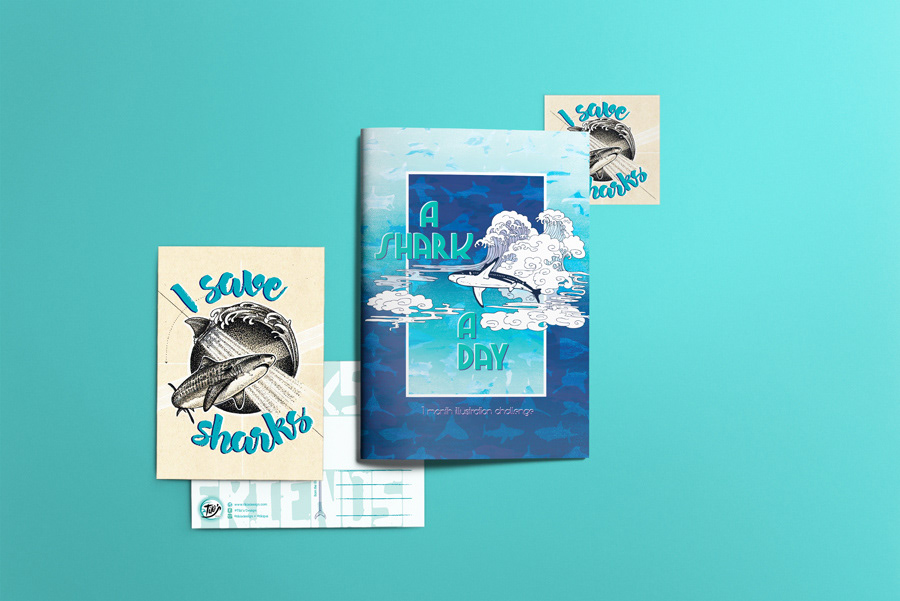
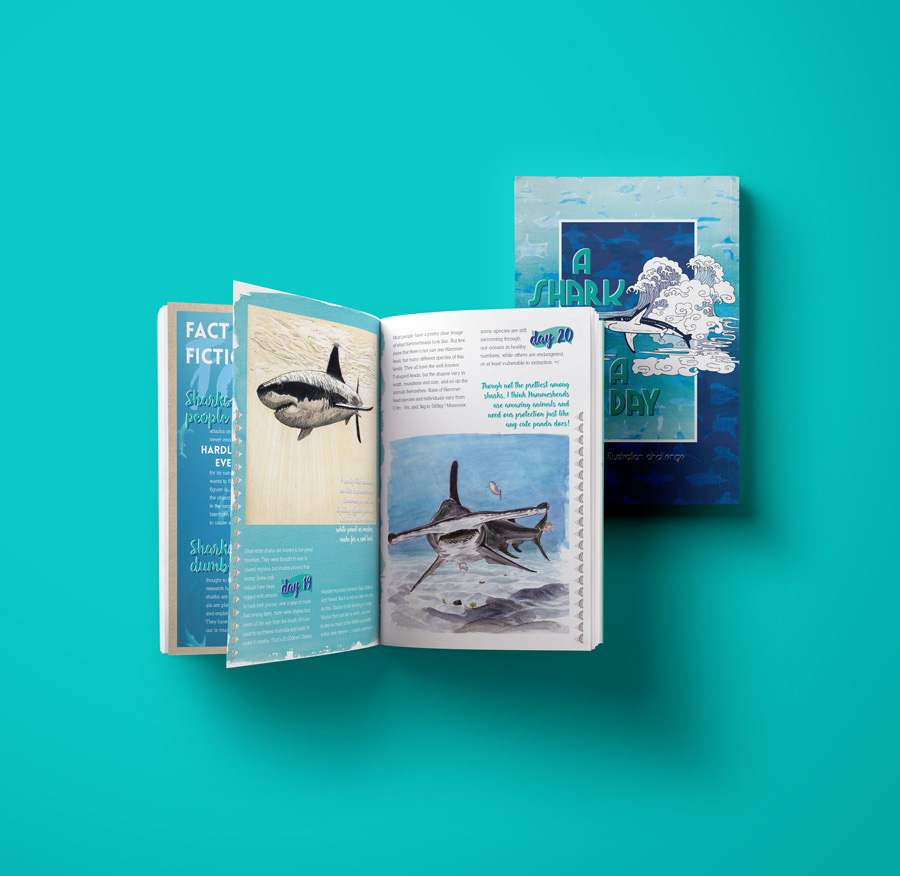
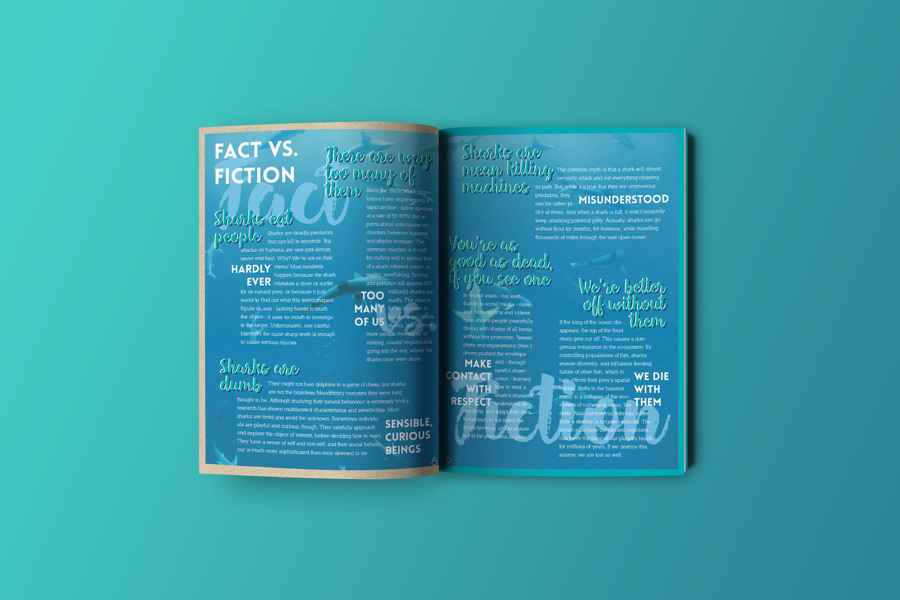

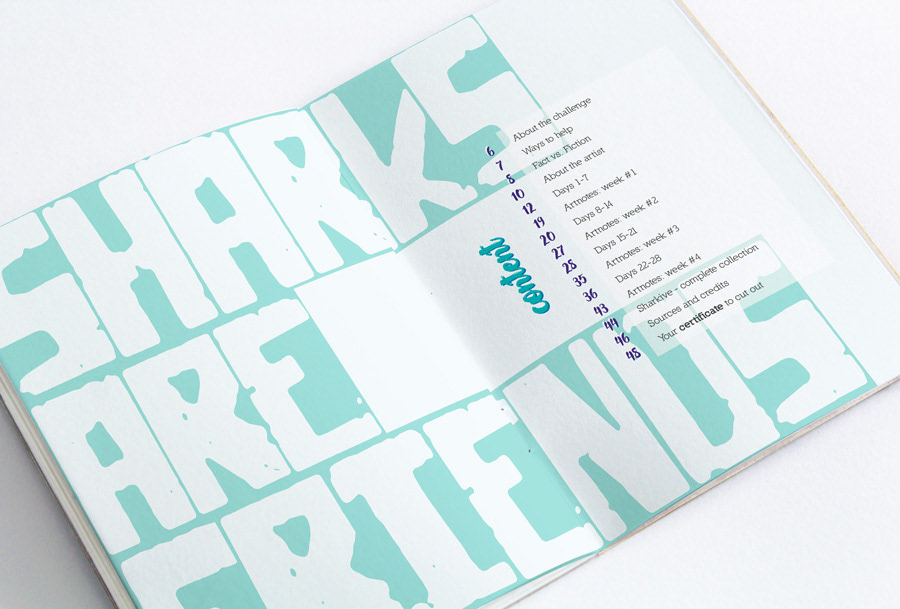
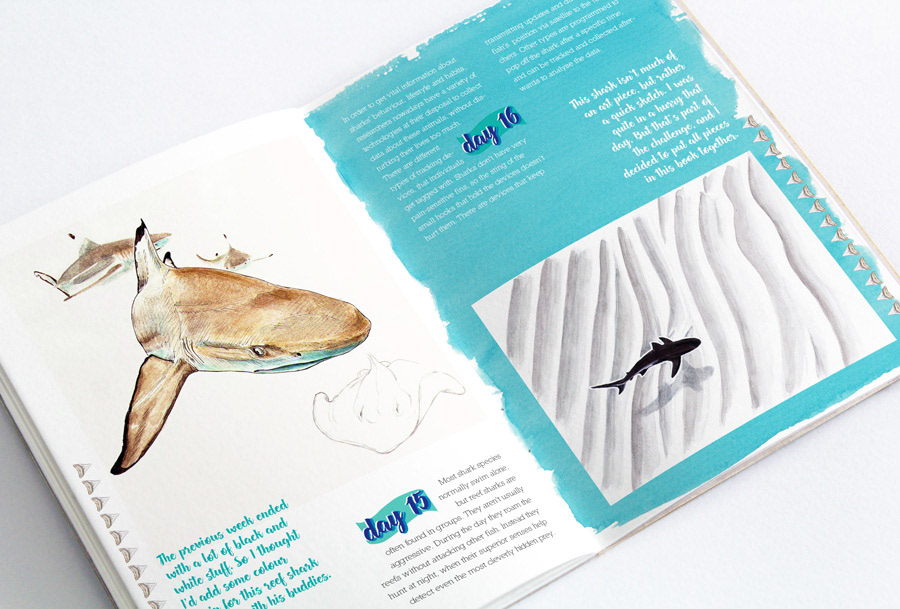
Project: This is a challenge I've been wanting to do for a while. Not only to re-establish a daily drawing habit, but also to create something that I can address an important issue with.
For one month I drew, painted, or at least sketched an image of sharks every day.
A shark a day...to keep the extinction away! (*hopes-up*)
The initial reason for this series was to raise awareness for the "real" character of those amazing animals and the fact that they are endangered and need our help to survive.
I added some info and interesting facts about their biology and behaviour, to correct the false image they still have in popular media. Let's not destroy this masterpiece of evolution, just because we're having a wrong conception of these animals! Without sharks our oceans will get even sicker than they are already.
A shark a day...to keep the extinction away! (*hopes-up*)
The initial reason for this series was to raise awareness for the "real" character of those amazing animals and the fact that they are endangered and need our help to survive.
I added some info and interesting facts about their biology and behaviour, to correct the false image they still have in popular media. Let's not destroy this masterpiece of evolution, just because we're having a wrong conception of these animals! Without sharks our oceans will get even sicker than they are already.
I also used this 4-week challenge to explore my skills and possibilities, looking for what "my style" of illustration actually is... I took these shark sketches as an opportunity to vary styles and techniques while keeping a theme.
But most importantly I wanted to use it as an opportunity to show everyone, what I learned to see in those amazing ocean creatures. Aiming to capture their beauty, character and charm.
But most importantly I wanted to use it as an opportunity to show everyone, what I learned to see in those amazing ocean creatures. Aiming to capture their beauty, character and charm.
Client: none
Format: various
Tools: all sorts - pen, pencil, marker, posca, watercolour,...etc.
Countdown
(FINISHED)
0
more to go!
(FINISHED)
0
more to go!
start here...
Day 0
Day 0
A little intro sketch, that was used as a teaser.
Day 1
Sharks are the ocean's cleaning patrol and play a vital role in the eco system of all 7 seas - and therefore ultimately in sustaining a healthy planet as well. We must fight for our oceans to be healthy and clean and for it's creatures to survive. All of them. No matter how scary they might seem to us. Sharks have inhabited these oceans for over 400 million years!! And they haven't changed much throughout evolution and the developements of our planet. They survived all catastrophes and dangers - exept for one: humans. =(
Day 2
These animals are hunted for their fins, and because people see them as monsters, that need to be killed, before they kill us. But in fact just about 30-50 shark attacks are reported every year, of which not more than 5-10% end fatal. In fact the chance to be bit and deadly injured by a shark is way smaller than to be killed by a dog, a wasp, a bee, snakes, even falling coconuts, or lightning! Keep that in mind, when you pet the next best doggy in the park. ;P
Day 3
When hearing of a "shark" most people think of a Great White or a Hammerhead, maybe a Tiger or reef sharks. But there are more than 500 species swimming through the world's oceans. Varying in size, shape and behaviour, they all share some very distinct characteristics, like their sophisticated sensory systems, flexible cartilaginous skeletons and having large livers. There are probably a lot more, that are still not discovered. The sad thing is, that some species have declined in population up to 90%, due to overfishing!
Day 4
My friends use to laugh at me, when I say sharks are friends and that they can be very cute ! If it wasn't for their razor teeth, sharp look in their eyes and the bad reputation, we would maybe go diving with them like we do with dolphins (they got teeth, too, you know!)
Day 5
The typical shape of sharks is something that always amazed me. I can't say how and why, but I just find it staggering, espescially in motion. The way they move through water, to me, is the ultimate embodiment of elegance and dynamic. It's like their whole body is a muscle perfectly formed and fine-tuned for quick and flexible movment in their element. It's what makes them such successful predators. And the fact that they've kept this body shape throughout hundreds of millions of years of evolution, is proof of it's efficiency. Many many great technological inventions, from large airplanes ..to microscopic scales adapted these features. if you ever get into bionic designs, the shark will cross your way more than once, and not only for its shape. It's an incredible masterpiece of nature. And it's on us to save it, by changing people's negative conception of it.
Day 6
The shark fact for you on this one is about their anatomy. The skeleton of sharks is entirely made of cartilage. It's much more elastic and soft than bone structures and gives these fish their flexibility in moving. When a shark dies, it's skeleton gets dissolved by the salty ocean water. That's why their teeth are the only souvenirs you can find down there.
Day 7
Whoohoo! This is day 7 of the "A Shark A Day" challenge! Meaning: first week is completed. The last drawing of this week was a challenge in itself. Almost didn't make it. I posted a sketch of this one in time. Unfortunately I could't upload the finished drawing anymore that night. So day 7 was published on day 8. But hey, it was done! Since I drew a shark from the back with no face the day before, I thought I'm finishing off the week with a closeup portrait to make up for it.
Sharks might seem scary with their razorteeth, but they get injured themselves very often. Scars on these predators are not only caused by prey that bites back, or rivalries, but often also by humans, especially when the sharks get tangled up in fishing nets or cut by ships' propellers. Shark skin heals incredibly fast, though. (I wish I knew how, because I could use some healing enhancement for my skate-injury and scars covered legs ;P)
Sharks might seem scary with their razorteeth, but they get injured themselves very often. Scars on these predators are not only caused by prey that bites back, or rivalries, but often also by humans, especially when the sharks get tangled up in fishing nets or cut by ships' propellers. Shark skin heals incredibly fast, though. (I wish I knew how, because I could use some healing enhancement for my skate-injury and scars covered legs ;P)
sketch state
Recap of Week #1
Here's an upshot of the first 7 days. It hasn't been easy to keep it up, I must admit. Next to all other stuff, that was actually challenging enough already, I had to pull all left-over energy together, to commit to this and draw everyday. A few nights I didn't get to bed before 2am. But I learned a few things, and I hope viewer/readers have, too. I was going to keep sketching another 3 weeks (much to my bf's chagrin, who thought I'd do this for a week, and looked quite worried that morning, when I announced starting into the second week ;p).
Day 8
On this day of the drawing challenge I had to keep it simple. The rather elaborate shark portrait from the previous da ate up a lot of time, that I had to make up for that day. ;) So here's a tiny lonely sharky swimming off my page... Where's he going, I wonder?
People fear sharks everywhere and some avoid open water or going into the ocean at all. In fact, what we should be much more afraid of, than oceans full of sharks,... is an ocean without any sharks at all!!
Most species are endangered and 20-30% are even close to extinction. After 400 million years of sharks playing an important and vital role in the ecosystem of the sea, humans have manage to decrease their numbers dramatically (some species up to 90%) within just a few decades of commercial fishing and finning.
We can not let this continue!
Most species are endangered and 20-30% are even close to extinction. After 400 million years of sharks playing an important and vital role in the ecosystem of the sea, humans have manage to decrease their numbers dramatically (some species up to 90%) within just a few decades of commercial fishing and finning.
We can not let this continue!
Day 9
Another day, yet another style... tried Posca pens on paper. Those are really well covering pens - much like acrylic paint. So it's hard to blend them, especially on materials that soak the paint in. But it was worth a try, I think.
You might notice, that this shark is of the same species as the one I drew the previous day. Blacktip reef sharks are easily recognisable by ...well, the black (and often black and white) dipped ends of their fins, as well as the darker lines on the sides. This colouration emphasizes their typically shark'ish shape and makes for a beautiful graphical appearance. Personally, I think these sharks are the prettiest among the smaller species. And they're fun to draw! :)
Reef sharks like those are very common in tropical regions. They prefer shallow waters and can get really social, swimming and hunting in groups over reefs. They are very timid, and tend to be scared away by humans. But there have been incidents, when they mistake peoples legs, wading through the water, with their natural prey. They realize their mistakes quickly enough though, so that those accidents wouldn't end fatal or life threatening. "near threatened" however, is what the IUCN has assessed the sharks themselves. They are not an actual target often fall prey to commercial fishing, being a regular catch in the nets in the Indo-Pacific region. This fate, they share with loads of other animals, like turtles, dolphins, small whales and many many other ocean creatures. Nowadays, there are plenty of alternative fishing methods available, that minimize the risk of catching untargeted animals. But changing traditional fishermen's minds, and making them invest in those methods is tough. This is one of the things that organizations for protection of sharks fight for.
Day 10
Someone in the comments of my Facebook page wished for a Hammerhead Shark. There you go! Went a bit more doodle-style on that one. I heard the days of "Zen tangle" are over soon, but why not give it a shot. Was wishing for some Zen that day. Didn't really get there, but at least the shark was finished.
Hammerhead sharks are really weird looking guys, aren't they. You'd wonder if this oddly shaped head (cephalofoils) isn't more of a handicap, than a thing that evolution would develop as a useful advantage. But in fact it is! Sharks use electrical sensors, usually on the sides of their heads and noses, to pinpoint their prey. With the hammerhead these sensors are spread out all over the wide surface area of their front end. This makes them very skilled hunters.
Hammerhead sharks are really weird looking guys, aren't they. You'd wonder if this oddly shaped head (cephalofoils) isn't more of a handicap, than a thing that evolution would develop as a useful advantage. But in fact it is! Sharks use electrical sensors, usually on the sides of their heads and noses, to pinpoint their prey. With the hammerhead these sensors are spread out all over the wide surface area of their front end. This makes them very skilled hunters.
Day 11
A very cute little fella. I travelled the whole day that day, and had to make it a quick sketch at night. So I thought at least I should make it fun and still nice to look at. And what could be better than a Thrasher Shark.
Now, you might think this is a cartoon drawing... But look at this picture and you'll see, that these #sharks really look that sweet and much more scared of you, than you could ever be of scared of them, ...after looking into their big eyes. Don't you think?! Such a cutie.
Day 12
First time in a while, that I used watercolour pencils for shading. Not my strong suit...
With most shark species the back fin, called caudal fin has a longer upper lobe and is is an extension of their backbone. Different lifestyles of different species are reflected in the shape of their caudal fin. The White Shark is part of the mackerel shark family. They're a fast-swimming shark type living in open waters. These sharks' tails are usually crescent-shaped with upper and lower lobes of almost equal size. The high aspect ratio of the tail serves to enhance swimming power and efficiency. In these species, there are usually also lateral keels on the caudal peduncle.
With most shark species the back fin, called caudal fin has a longer upper lobe and is is an extension of their backbone. Different lifestyles of different species are reflected in the shape of their caudal fin. The White Shark is part of the mackerel shark family. They're a fast-swimming shark type living in open waters. These sharks' tails are usually crescent-shaped with upper and lower lobes of almost equal size. The high aspect ratio of the tail serves to enhance swimming power and efficiency. In these species, there are usually also lateral keels on the caudal peduncle.
Day 13
Due to travelling over the weekend, I kept the shapes simple and the shading and texture easy to make on the go (shaky trains aren't suitable for hatching techniques..;) )
Did you know that reef sharks have been specified by the WWF as one of the most important species on the entire planet!? There are five reef shark species: the Grey reef shark, the Caribbean reef shark, and the Blacktip, Whitetip and Silvertip reef shark.
With about 1,6m to 3m body length, they're not the largest of their kind, but are the apex predators in every reef. Their role on top of the food chain of those delicate eco systems is of mostly unnoticed importance. So humans' fear of sharks and more and more diving tourism endangers the already fragile reefs. also by chasing away or scaring off the sharks. Because they are often rather timid animals and attacks on humans are very rare.
With about 1,6m to 3m body length, they're not the largest of their kind, but are the apex predators in every reef. Their role on top of the food chain of those delicate eco systems is of mostly unnoticed importance. So humans' fear of sharks and more and more diving tourism endangers the already fragile reefs. also by chasing away or scaring off the sharks. Because they are often rather timid animals and attacks on humans are very rare.
Day 14
Here's the half-time illustration I finished off the 2nd week with. Day 14 of the challenge was another technical challenge for myself. I started to run out of patience with just drawing images of a single shark every day. So after drawing one with a surrounding scenery on day 13, this time it turned out more geometrical and abstract. I've avoided drawing Tiger Sharks til now, even though I love their beautiful pattern. But it's not easy to capture.
Tiger Sharks are among the largest shark species. With up to 7.5m their maximum length is still less than that of Great Whites, Basking sharks or, of course, Whale sharks. They are very easy to recognise, because of the rather narrow snout and blunt nose. And they are the only sharks this size with that awesome colouring. But their dotted and striped pattern fades in contrast when they get old.
Recap of Week #2
So at this point half of the 4 weeks challenge was over! This is the recap of week 2.
It hasn't been any easier to make time and space for the daily drawing, especially because I went travelling to Germany at the weekend. But as skate-tutorial-video guru Aaron Kyro always says: You gotta commit!! ;)
As a conclusion, looking back at the last 7 drawings, I'd say I'm getting a hang of the shape and proportions of shark anatomy. There's still a lot to study and explore, also regarding different drawing techniques and illustration styles. So I'm looking forward to week 3.
Day 15
Last week ended with a lot of black and white stuff. So I thought I'd add some colour again for this reef shark roaming with his buddies. Actually I wanted to give them a blue water background, but I was afraid to ruin the whole illustration by applying my still rather humble watercolour skills. Maybe I'll do that later on, when I got better at it... ;)
Most shark species normally swim alone, but reef sharks are often found in groups. They aren't usually aggressive. They roam the reefs during the day without attacking other reef fish, but they go hunting at night.
Most shark species normally swim alone, but reef sharks are often found in groups. They aren't usually aggressive. They roam the reefs during the day without attacking other reef fish, but they go hunting at night.
Day 16
This shark isn't much of an art piece, but rather a quick sketch with shading. Been quite in a hurry that day. But bear with me... Better stuff will follow. ;)
Speaking of following: In order to get vital information about sharks' behaviour, lifestyle and habits, researches nowadays have a variety of technologies on their hands to collect data about these animals without disturbing their lives too much. There are different types of tracking devices, that individuals get tagged with. Sharks don't have very pain-sensitive fins, so the sting of the small hooks that hold the devices doesn't hurt them. There are devices that keep transmitting updates and data about the fish's position via satellite to the researchers. Other types are programmed to pop off the shark after a specific time and can be tracked and collected afterwards to analyse the data.
Speaking of following: In order to get vital information about sharks' behaviour, lifestyle and habits, researches nowadays have a variety of technologies on their hands to collect data about these animals without disturbing their lives too much. There are different types of tracking devices, that individuals get tagged with. Sharks don't have very pain-sensitive fins, so the sting of the small hooks that hold the devices doesn't hurt them. There are devices that keep transmitting updates and data about the fish's position via satellite to the researchers. Other types are programmed to pop off the shark after a specific time and can be tracked and collected afterwards to analyse the data.
Day 17
Here's a shark illustration made after my flight to Portugal - travelling is inspiring. ;) Despite being on a surftrip (or as I should call it surf-bootcamp) at this time, I tried to catch up on the sharks and kept sharing as often as I could. There should be 28 sharks by the end of the challenge.
Day 18
A simple posca drawing of a group of Hammerhead sharks for day 18. Had to make it quick, due to tiredness after a day of surfing, walking and wandering.
Most shark species usually swim and hunt solo, but Hammerheads are known to form groups of up to several hundreds of individuals (much like some dolphin species). They live in temperate and tropical waters and close to reefs and in shallow waters. But they can dive about 80m.
Most shark species usually swim and hunt solo, but Hammerheads are known to form groups of up to several hundreds of individuals (much like some dolphin species). They live in temperate and tropical waters and close to reefs and in shallow waters. But they can dive about 80m.
Day 19
Another Great white shark. Or in this case black and white ;) I really like drawing on this brownish unbleached paper. The lighting effects you can achieve with a simple white pencil or marker, make a cool look I think.
Great white sharks are known to be great travellers. They were thought to stay in coastal regions but studies proved that wrong. Some individuals had been tagged with sensors to track their journey over a year or more, and among them, there were sharks that swam all the way from the South African coast to northwest Australia and back in under 9 months. That's 20.000km! Others migrate regularly between Baja California and Hawaii. But it is still not clear why they do this. Maybe for feeding or mating. Maybe they just like to swim and want to see as much of the World as possible within their lifetime :) I could understand!
Great white sharks are known to be great travellers. They were thought to stay in coastal regions but studies proved that wrong. Some individuals had been tagged with sensors to track their journey over a year or more, and among them, there were sharks that swam all the way from the South African coast to northwest Australia and back in under 9 months. That's 20.000km! Others migrate regularly between Baja California and Hawaii. But it is still not clear why they do this. Maybe for feeding or mating. Maybe they just like to swim and want to see as much of the World as possible within their lifetime :) I could understand!
Day 20
Here's a Hammerhead shark painted with watercolour. I'm going to start taking some private lessons in watercolour technique from my lovely neighbour and artist Hanneke Sadgui this weekend. I'm still unhappy with my colourings, so I look forward to learn from an experienced and trained artist like her. ^-^
As for today's shark education: Most people recognise Hammerheads right away. But few know, that there's not just one, but many different species of Hammerhead sharks. They all have the well-known T-shaped heads, but the shapes vary in width, roundness and size. And so do the animals themselves. Sizes of hammerhead species and individuals vary from 0.9m - 6m, and 3kg to 580kg ! Moreover, some species are still swimming through our oceans in healthy numbers, while others are endangered or at least vulnerable to extinction. =/ Though not the prettiest among shark species I think they are amazing animals and need our protection just like any cute panda does!
As for today's shark education: Most people recognise Hammerheads right away. But few know, that there's not just one, but many different species of Hammerhead sharks. They all have the well-known T-shaped heads, but the shapes vary in width, roundness and size. And so do the animals themselves. Sizes of hammerhead species and individuals vary from 0.9m - 6m, and 3kg to 580kg ! Moreover, some species are still swimming through our oceans in healthy numbers, while others are endangered or at least vulnerable to extinction. =/ Though not the prettiest among shark species I think they are amazing animals and need our protection just like any cute panda does!
Day 21
That means 3 weeks of daily shark drawings are finished with this illustration right here. The uploads will continue day by day, until all 28 sharks are shared. (It's a 1-month-challenge, but it took place in February :p)
This tough dude here is swimming with his little pilot fish friends. Especially Oceanic Whitetip sharks are often followed by a bunch of these pilot fish. They have a mutualist relationship. The fish get protection by the shark, which in return stays free of parasites, because they eat it off the shark's skin. The Oceanic Whitetip itself is not protected by this of course. Certainly not from humans. Their special feature - long, round white-tipped fins - is highly valued as the main ingredient in sharkfin soup. ;( Their population is on the decline rapidly. Shark finning is such a cruel practice. Often the animals get caught, get their fins cut off and are thrown back overboard - alive, to slowly and painfully die. So never ever ever even think about ordering shark soup, and please help boycotting every place that serves or sells shark fins or any other shark products!
Thank you!
This tough dude here is swimming with his little pilot fish friends. Especially Oceanic Whitetip sharks are often followed by a bunch of these pilot fish. They have a mutualist relationship. The fish get protection by the shark, which in return stays free of parasites, because they eat it off the shark's skin. The Oceanic Whitetip itself is not protected by this of course. Certainly not from humans. Their special feature - long, round white-tipped fins - is highly valued as the main ingredient in sharkfin soup. ;( Their population is on the decline rapidly. Shark finning is such a cruel practice. Often the animals get caught, get their fins cut off and are thrown back overboard - alive, to slowly and painfully die. So never ever ever even think about ordering shark soup, and please help boycotting every place that serves or sells shark fins or any other shark products!
Thank you!
Recap of Week #3
Here's another recap. 3rd week of daily shark illustrations.
There are always good days and bad days. Days with more or less time to sketch. And days with, or without inspiration. But I'm going to continue this #asharkaday challgenge with experiments and variations.
So stick around for the next 9 sharks . ;)
And please feel invited to leave me a comment down below! I'd really love to know what you think of my sketches. Critiques, likes, dislikes, favourites, or suggestions for the next drawings - let me know! =)
Thanks a lot guys!
There are always good days and bad days. Days with more or less time to sketch. And days with, or without inspiration. But I'm going to continue this #asharkaday challgenge with experiments and variations.
So stick around for the next 9 sharks . ;)
And please feel invited to leave me a comment down below! I'd really love to know what you think of my sketches. Critiques, likes, dislikes, favourites, or suggestions for the next drawings - let me know! =)
Thanks a lot guys!
Day 22
Trying to use less lines... actually less everything. How many shades and shapes are neccessary to make a shark visible on paper? I think even much less than this. But for a detail-obsessed illustrator like me, it's a start.
Speaking of visibility - Sharks can see very well in fact, even in murky water. They have a membrane in the back of the eye (the tapetum lucidum), which reflects sunlight back into the eye. That helps the sharks to use even the smallest amount of surface light to see underwater.
Speaking of visibility - Sharks can see very well in fact, even in murky water. They have a membrane in the back of the eye (the tapetum lucidum), which reflects sunlight back into the eye. That helps the sharks to use even the smallest amount of surface light to see underwater.
Day 23
This day's sharky is painted with watercolour, to add in a splash of colour among the last few black and white illustrations. Also to keep practicing painting techniques, that I learned rather recently.
Did you know that most shark species, like the Great White, Mako sharks and many others, have to keep swimming in order to breathe? They would literally drown, if they stopped moving for too long. They don't have muscles to pump water through their mouths and over the gills. So the only way to survive is to keep the water flowing by moving through the sea.
Did you know that most shark species, like the Great White, Mako sharks and many others, have to keep swimming in order to breathe? They would literally drown, if they stopped moving for too long. They don't have muscles to pump water through their mouths and over the gills. So the only way to survive is to keep the water flowing by moving through the sea.
Day 24
I experimented with this drawing style on day 14 already and really liked it. It's rather time-consuming, to use nothing but dots to create shades and shapes, but it gives very good control over the shading and is quite forgiving, when making mistakes. It can end up looking a bit dull though, if you don't pay close attention to contrasts. What do you guys think of this style?
A shark fact I can think of for this pic of the day is, that sharks actually rarely expose their dorsal fin over the surface as it is popularly shown in movies or images. They usually don't surface much at all, if they're not lured up there by bait or actual prey. Of course, if they enter shallower waters, their fins will knife through the waves as a result, but other than that, it's just one more common myth, that you'll see a shark approach to prey in this way.
After all, they're much more successful in hunting, if they speed up to their prey from down below as a surprise.
A shark fact I can think of for this pic of the day is, that sharks actually rarely expose their dorsal fin over the surface as it is popularly shown in movies or images. They usually don't surface much at all, if they're not lured up there by bait or actual prey. Of course, if they enter shallower waters, their fins will knife through the waves as a result, but other than that, it's just one more common myth, that you'll see a shark approach to prey in this way.
After all, they're much more successful in hunting, if they speed up to their prey from down below as a surprise.
I know, it's scary, but if you ever entered deep waters, chances are you've had a (peaceful) shark swimming somewhere beneath you without even noticing. ;P
And see: you're alive!
Day 25
Putting the big one on the smallest piece.
Been postponing to draw a Whale Shark for way too long. I'm absolutely in love with their beautiful pattern and majestic appearance! But with all the extra pattern to draw, I feared I wouldn't finish one in a day.
So eventually, for day 25 of the challenge, I gave it a go. Yet, "cheating" a bit, by just roughly shading it's shape with fat posca markers, to avoid having to elaborate too many details... haha. Sorry! I promise you'll get to see another Whale Shark , in a different style soon.
Been postponing to draw a Whale Shark for way too long. I'm absolutely in love with their beautiful pattern and majestic appearance! But with all the extra pattern to draw, I feared I wouldn't finish one in a day.
So eventually, for day 25 of the challenge, I gave it a go. Yet, "cheating" a bit, by just roughly shading it's shape with fat posca markers, to avoid having to elaborate too many details... haha. Sorry! I promise you'll get to see another Whale Shark , in a different style soon.
Did you know, Whale sharks are the largest fish on earth?!
They are about 9-12m on average, but can reach a length of up to 20m. Yet it is the most peaceful of all sharks.
They are about 9-12m on average, but can reach a length of up to 20m. Yet it is the most peaceful of all sharks.
It feeds on plankton and small fish, which it simply sucks into it's huge wide mouth. Which - harmless as it looks compared to, say, a White shark's open mouth - contains 300-350 rows of teeth!!
That's 3000+ teenytiny sharkteeth in there, man!!
Still - no reason to fear this soft giant. The teeth aren't actually used for feeding, since they employ a suction + filtering method. Scientists aren't sure exactly why this incredible animal has teeth at all.
That's 3000+ teenytiny sharkteeth in there, man!!
Still - no reason to fear this soft giant. The teeth aren't actually used for feeding, since they employ a suction + filtering method. Scientists aren't sure exactly why this incredible animal has teeth at all.
Maybe just so it can still feel like a shark - duh! ;P
Day 26
This illustration is one that I was meaning to do for a while, because I love the picture so much. I'd like to call it "the dancers". Freediving with sharks must be one of the most extraordinary experiences of a lifetime. <3
Definitely on the #bucketlist!
Definitely on the #bucketlist!
Images like this need to be shown much more often. Despite the wave of positive shark propaganda going on throughout media in the last few years, there is still too many fiction and false images about them in people's heads.
Animals that we find cute, or hold dear, even some of our pets cause hundreds, or even thousands of more deaths each year, than sharks do! Tigers, horses, cows, even pet dogs!
The difference is, that a shark's appearance, face and eyes, are not as easy for us to identify emotions with.
Tigers can look so cute, we love them. Not to mention dogs... We feel closer to them and tend to interpret human-like emotions and intentions into their mimic and behaviour.
Sharks are intelligent creatures, too! They're curious and careful. But having avoided and rather killed them over centuries, we've never had the chance to actually study their behaviour to a point where we can identify with them.
The difference is, that a shark's appearance, face and eyes, are not as easy for us to identify emotions with.
Tigers can look so cute, we love them. Not to mention dogs... We feel closer to them and tend to interpret human-like emotions and intentions into their mimic and behaviour.
Sharks are intelligent creatures, too! They're curious and careful. But having avoided and rather killed them over centuries, we've never had the chance to actually study their behaviour to a point where we can identify with them.
There's a shift in that approach going on now, but we've only just begun to understand them.
Have an open mind for creatures, no matter how scared you may be of them (unreasonably, maybe..;) )
Have an open mind for creatures, no matter how scared you may be of them (unreasonably, maybe..;) )
Thank you for reading this!
And please remember sharing is caring! ^-^
And please remember sharing is caring! ^-^
Day 27
A gorgeous little Leopard Shark from the second to last day of the challenge.
You gotta love these markings they're wearing! I've been asked if they really look like that. They DO!
In fact their pattern is even more sophisticated and pretty than I (lazily) captured in this sketch.
Just google "leopard shark" and you'll be amazed.
You gotta love these markings they're wearing! I've been asked if they really look like that. They DO!
In fact their pattern is even more sophisticated and pretty than I (lazily) captured in this sketch.
Just google "leopard shark" and you'll be amazed.
They're not to be confused with Tiger Shark cubs (also worth a google), yet similarly small. They only grow to about 1,20m - 1,50m and are harmless to humans. Their main habitat is the North East of the Pacific, thus along the Californian coastline and the Gulf of Mexico.
Unfortunately, their unique appearance makes them a popular catch for sports fishermen as well as those, who sell shark meat. But at least in the waters of California and Oregon, they've recently become protected, to save them from overfishing.
It's a start!
Day 28 (FINAL)
So this is it now, guys! The LAST piece of a-shark-a-day.
But it's not the end of the mission!
Did you like this 4 weeks daily drawing challenge from February?
Then please like anf subscribe to notifications of my Facebook page, so you don't miss out on the special output I'm going to share with you very soon!! =D *surprise*!
It's almost April by now... and I'm feeling a bit ashamed, that I didn't manage to upload and share all the drawings with you in time. But sometimes other obligations require higher priority over personal art projects. ;)
If you followed me up to this point, I want to shout out a
BIG THANK YOU!
Especially to everyone, who read this down to here, or clicked the like button under any of the drawings in FB or Instagram. Your action boosted the motivation to keep on going. And it helped creating sketches and artworks throughout rough times.
Recap of Week #4
I hope you enjoyed this series, even if you're not as fanatic about sharks as I am. ;)
I already accomplished what I set out to do, if anyone actually learned one thing or two by reading my little shark-facts.
Now, that said, I ask you to feel inside yourself.
Do you maybe want to consider actually helping to save the oceans and their creatures more actively? If you do, but don't now how, please stick around - follow my posts, and find out soon!
I got something coming up for you!
Do you maybe want to consider actually helping to save the oceans and their creatures more actively? If you do, but don't now how, please stick around - follow my posts, and find out soon!
I got something coming up for you!
Stay tuned for more ! =)
#asharkaday
#asharkaday
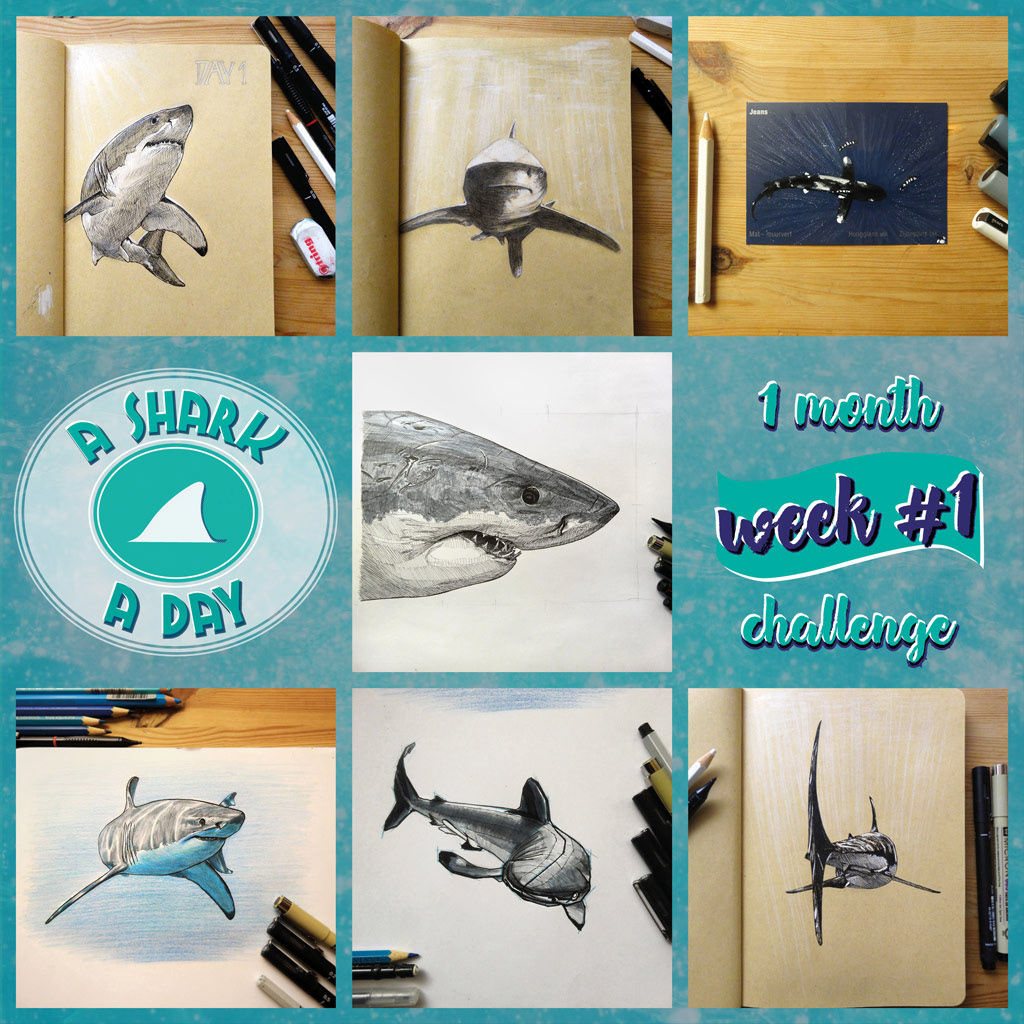
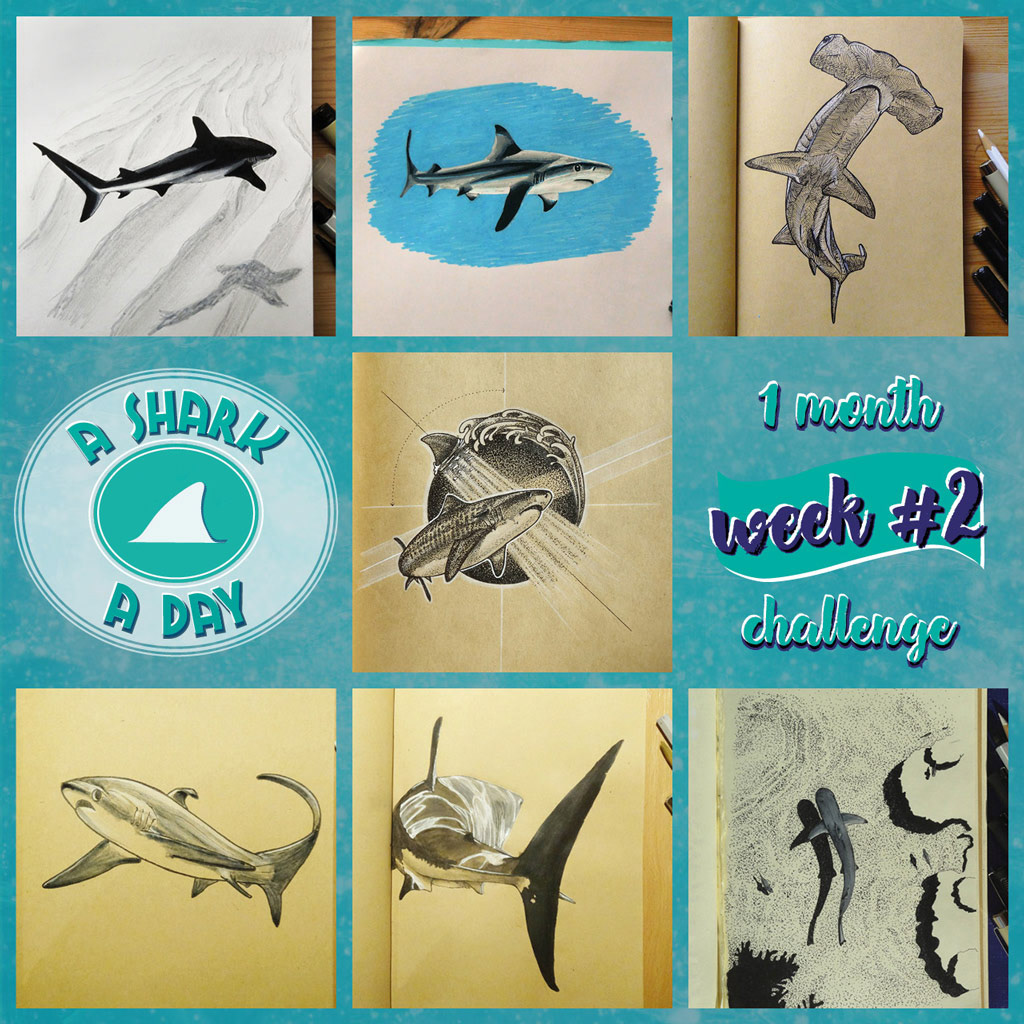
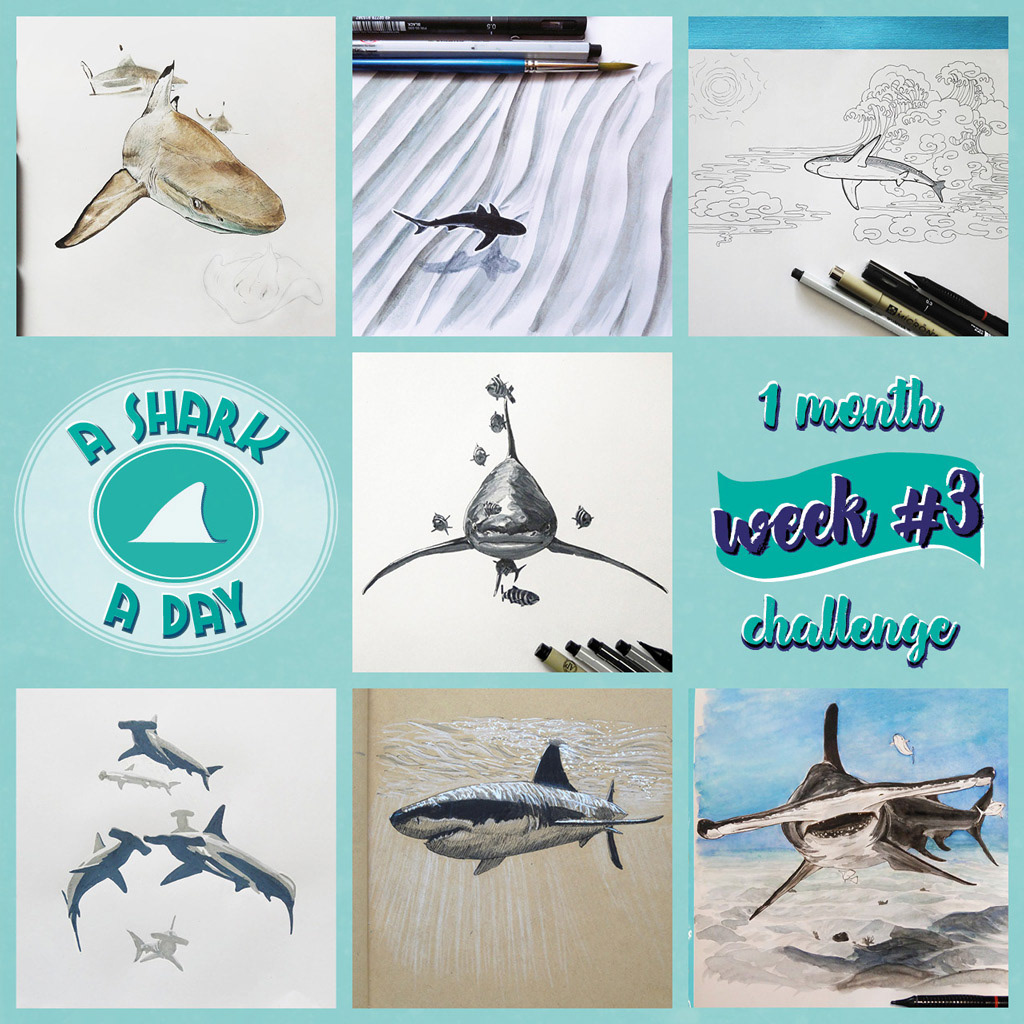


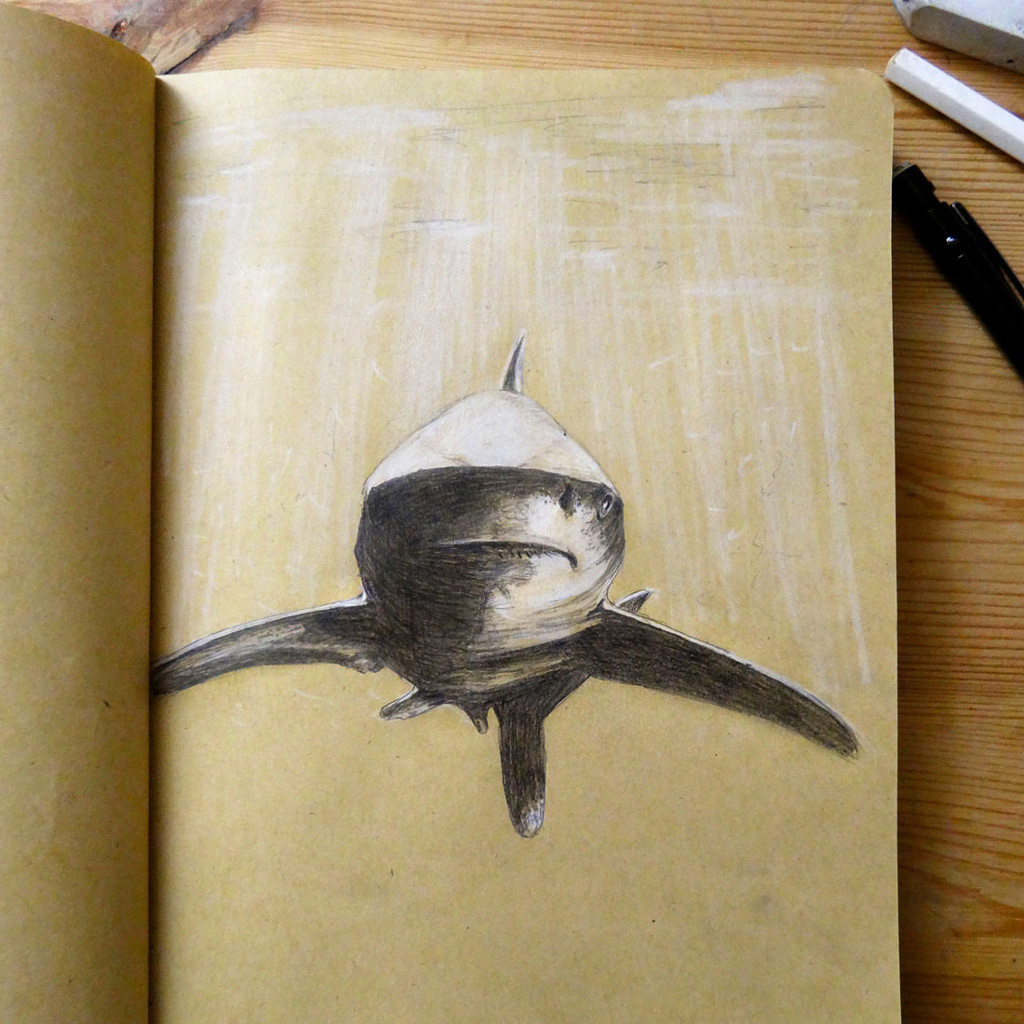
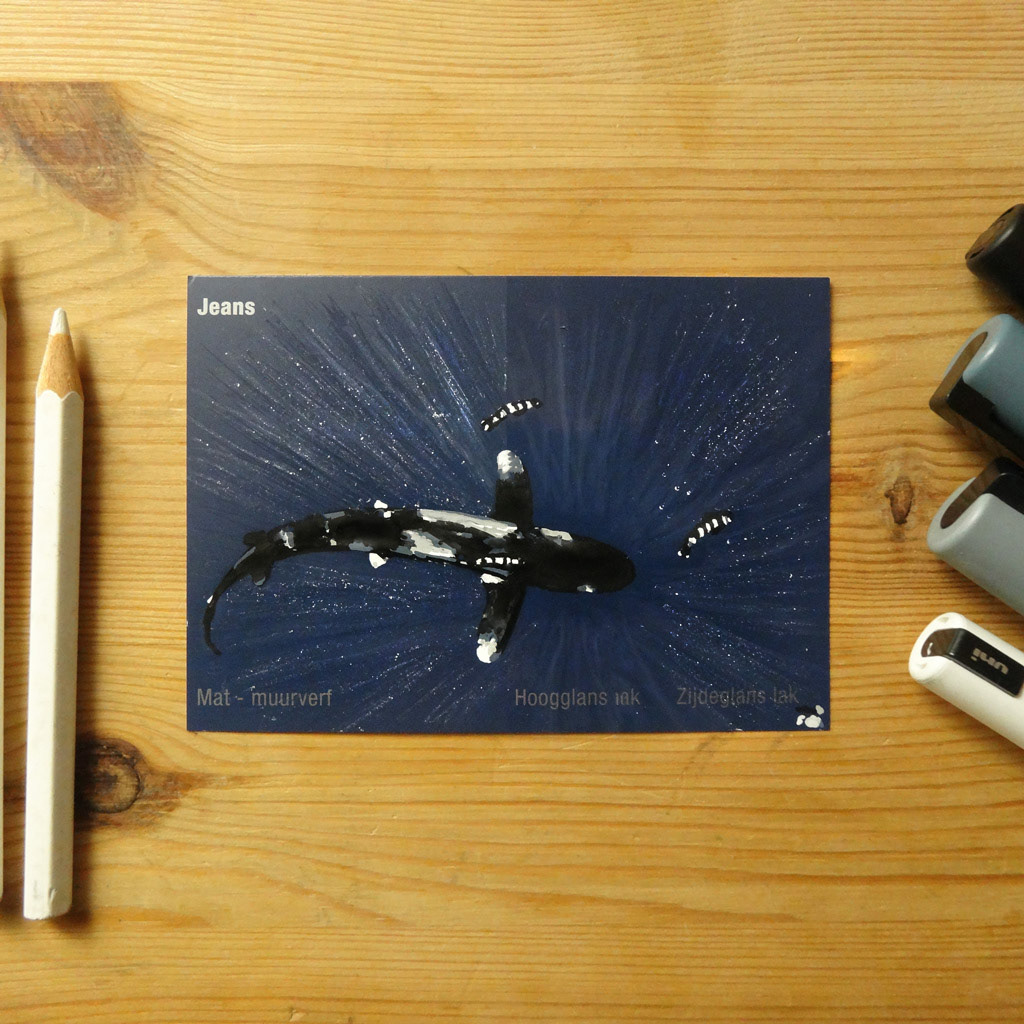

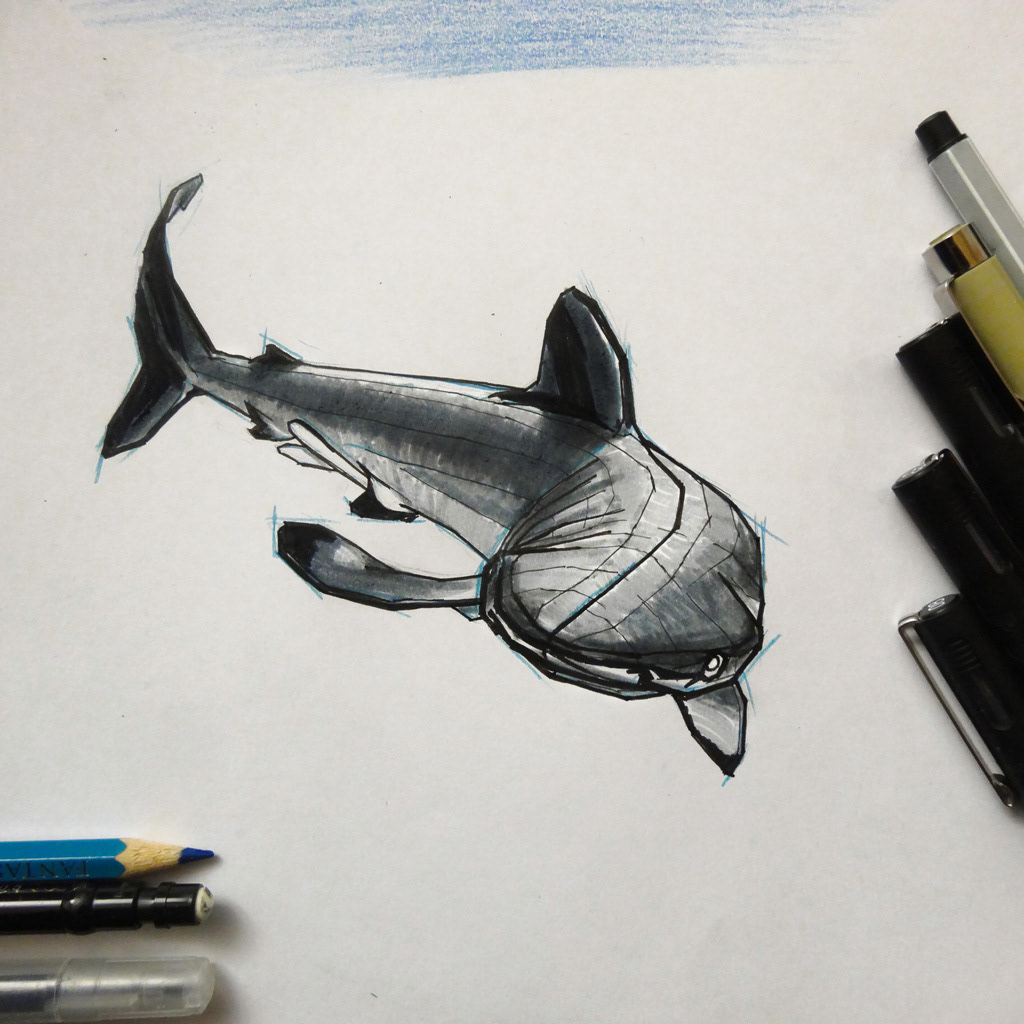
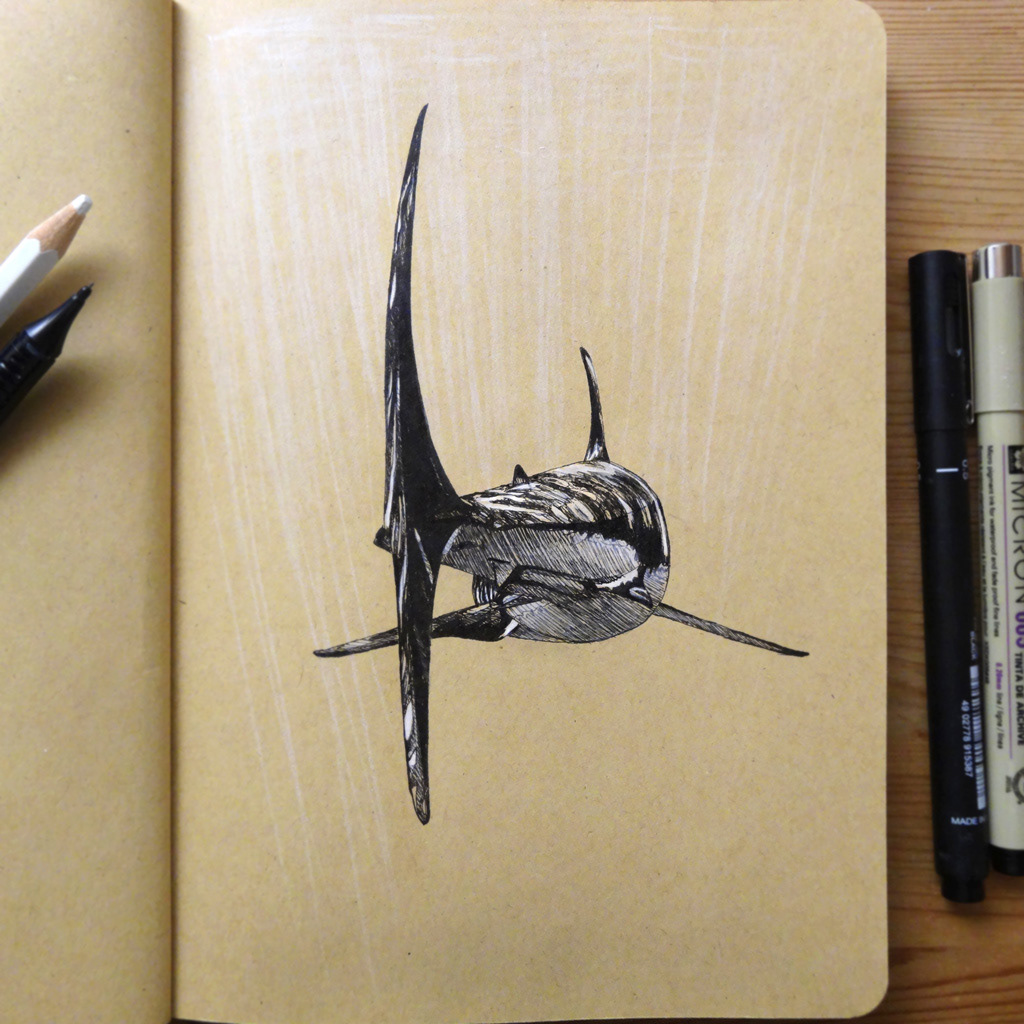


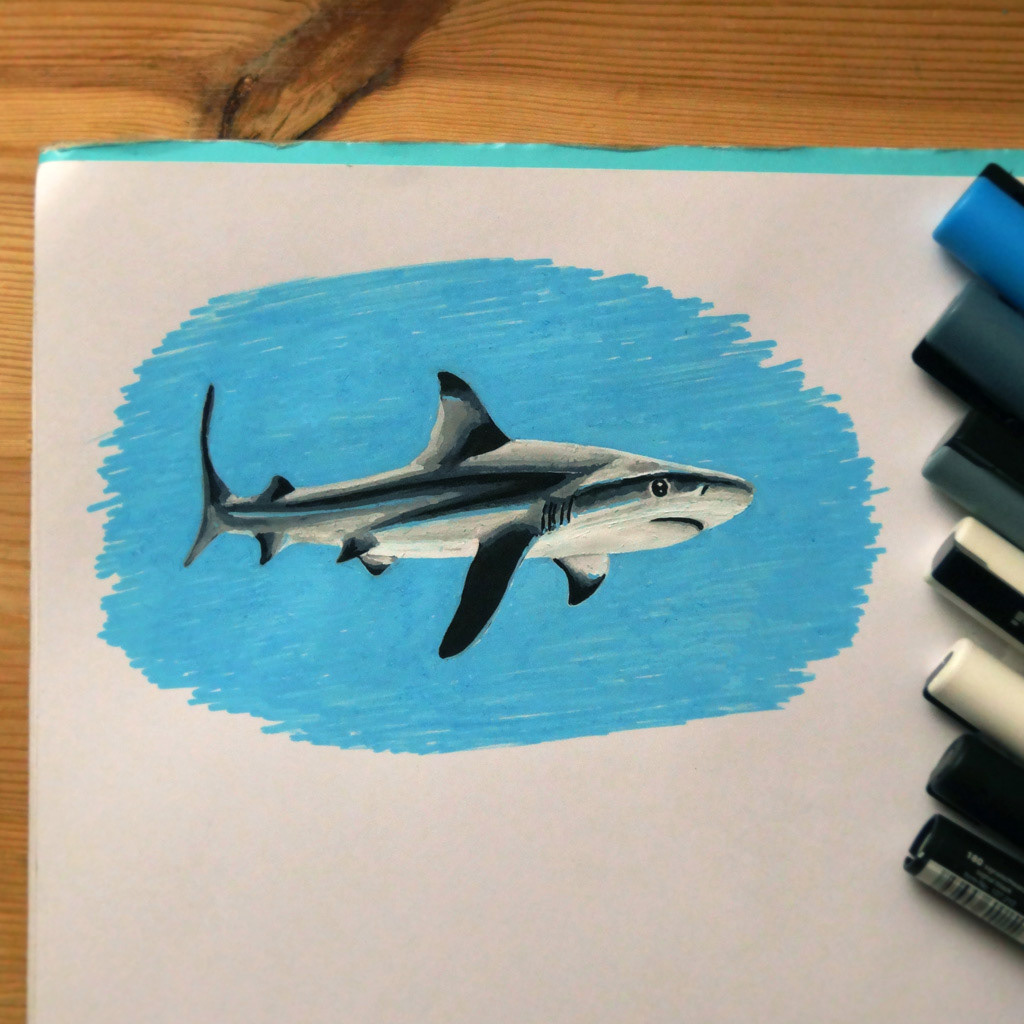
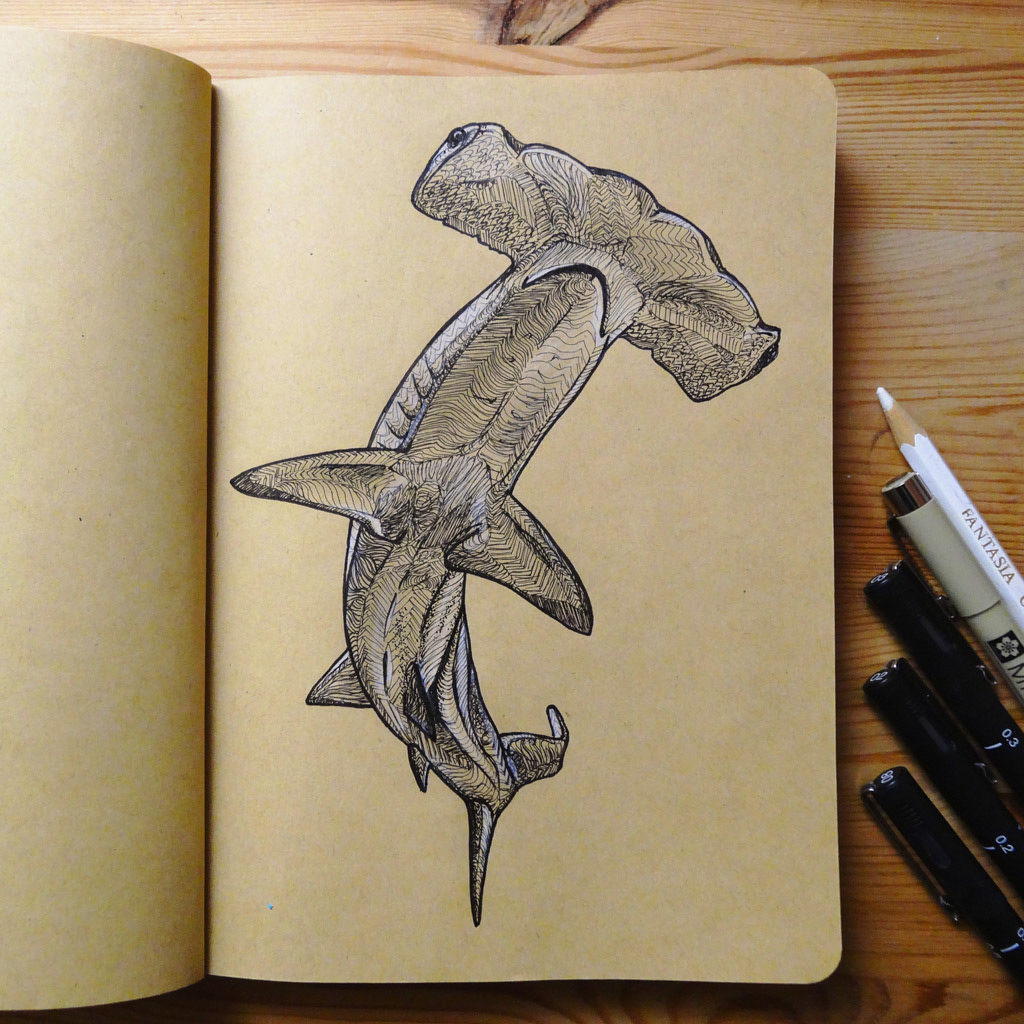
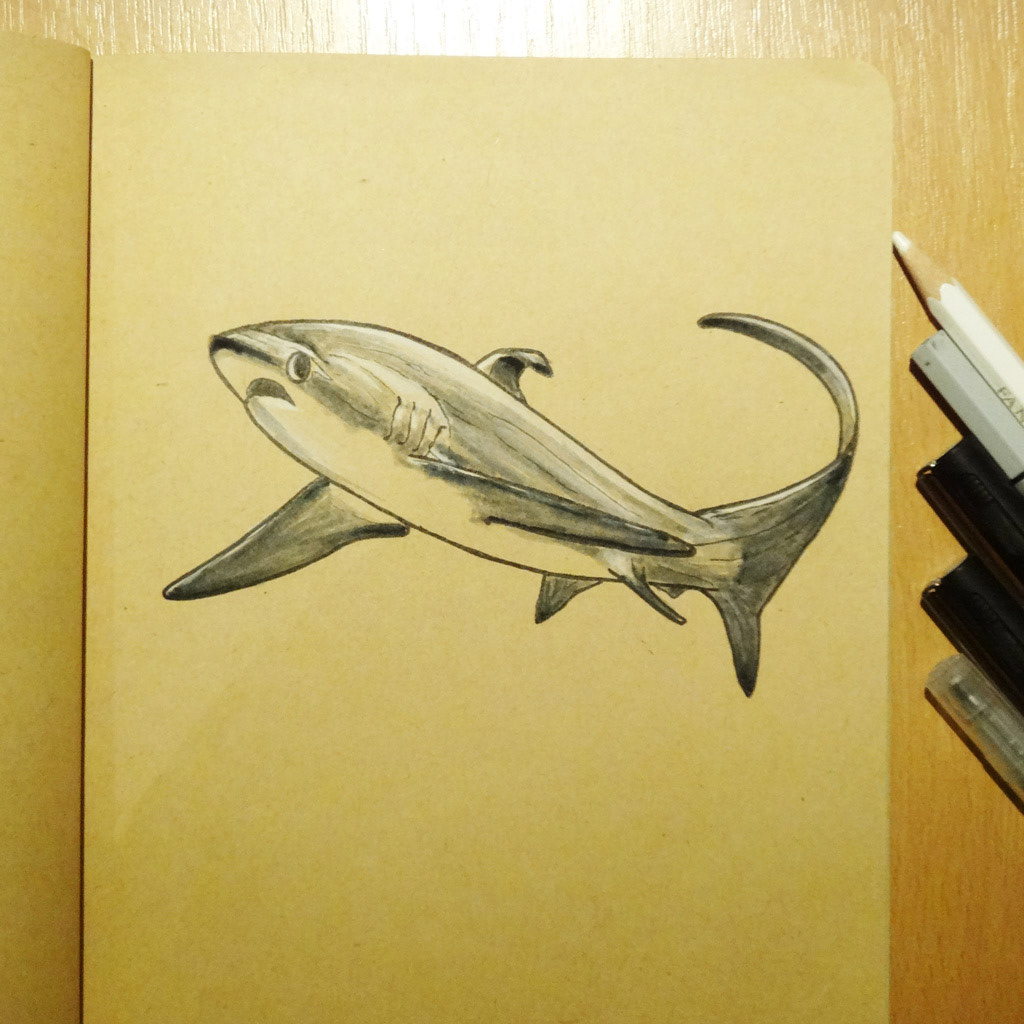
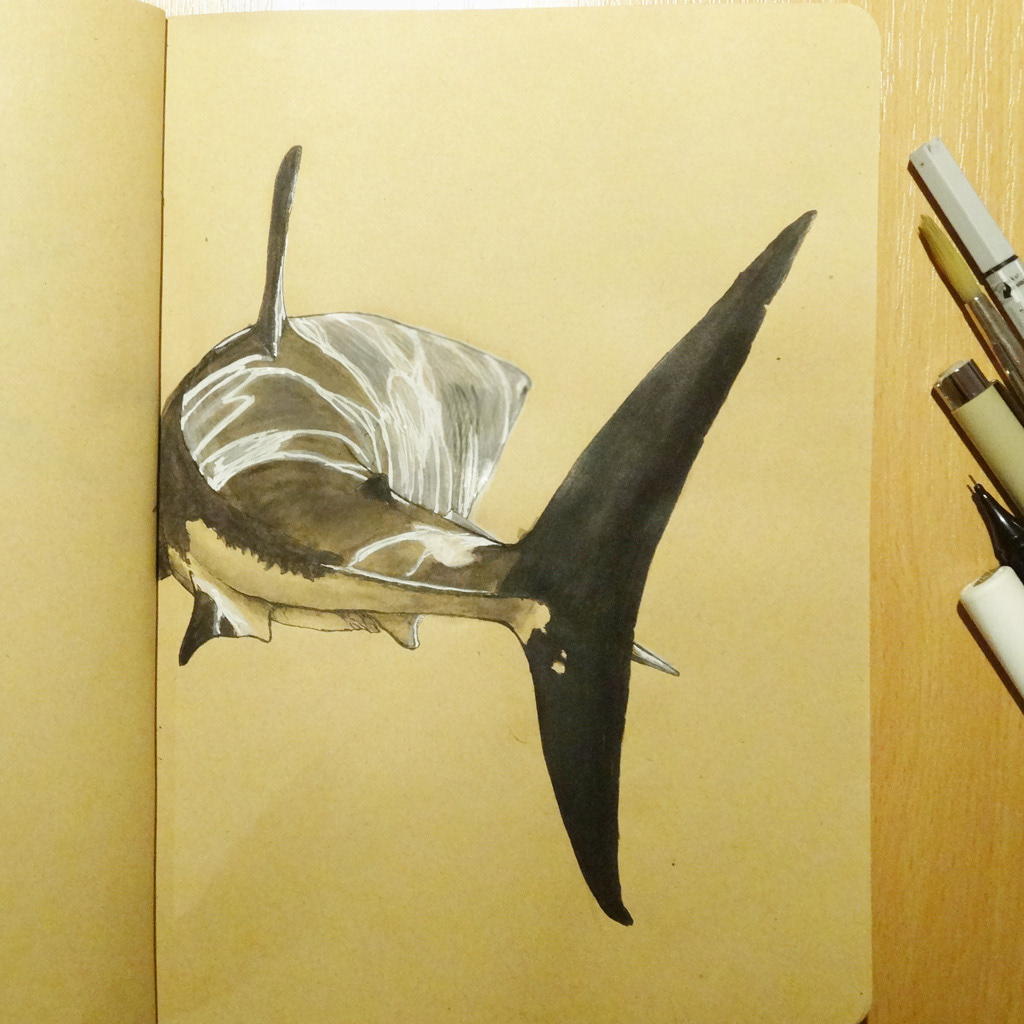
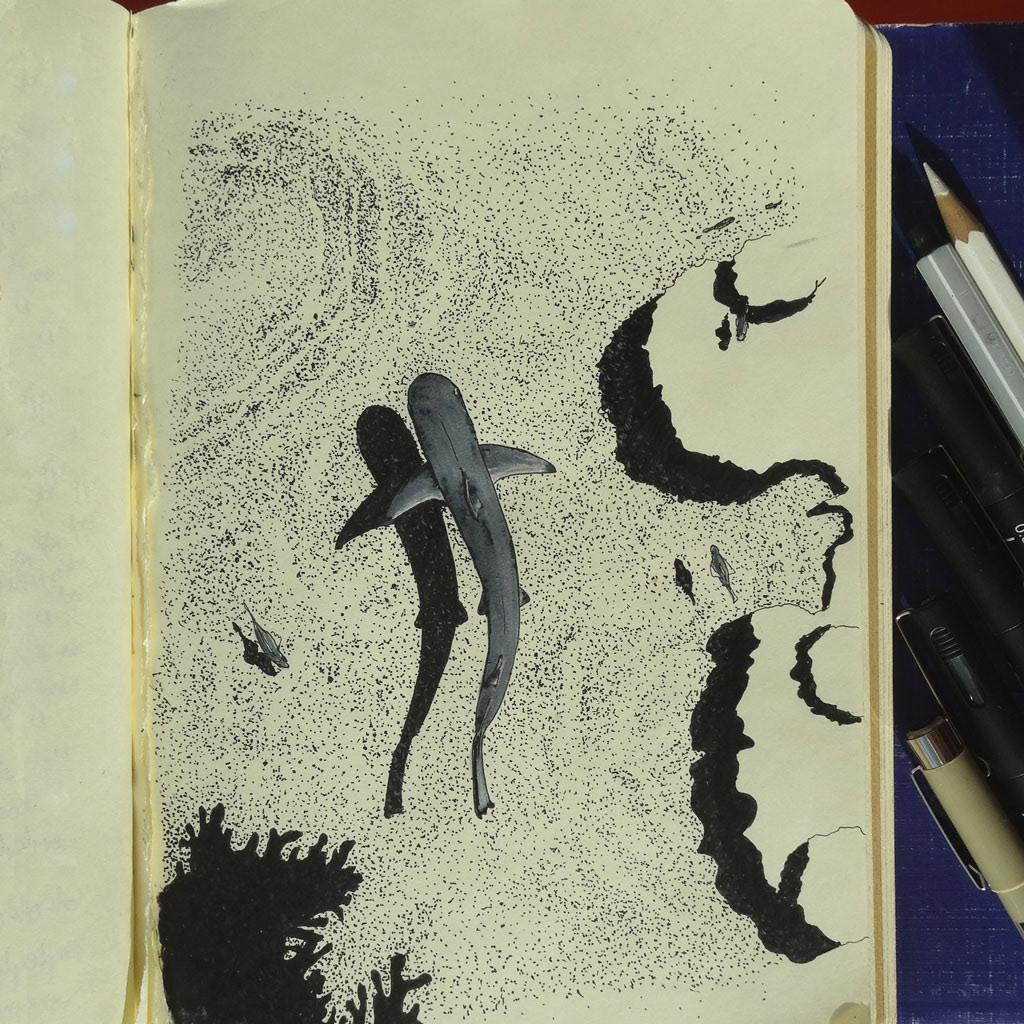
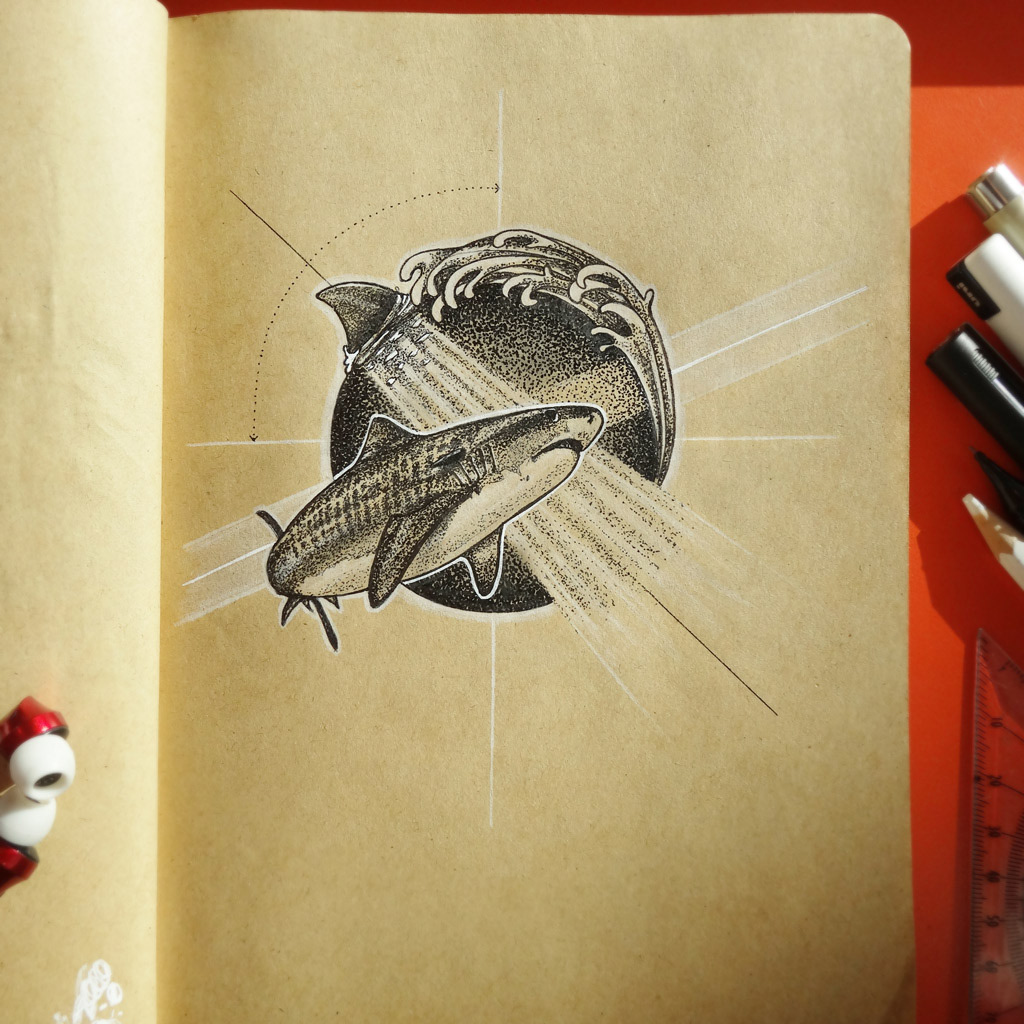
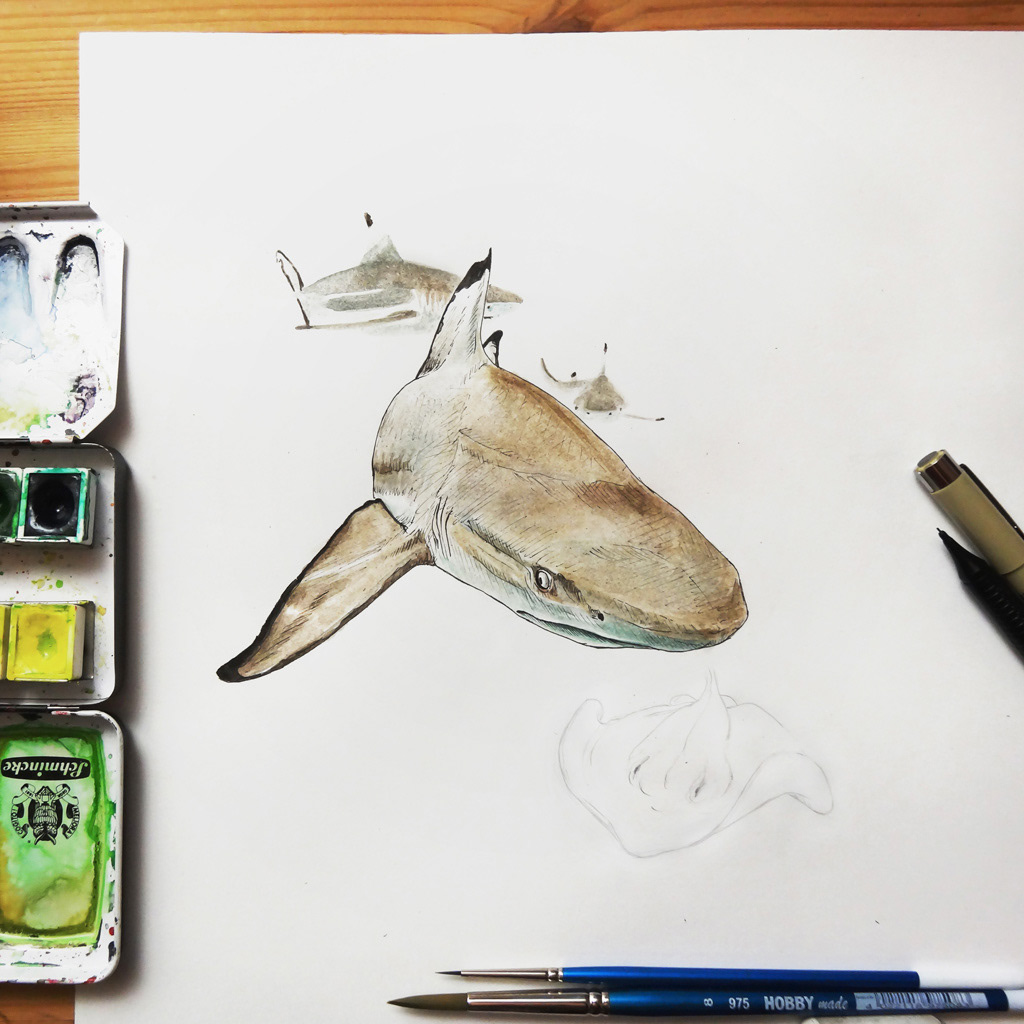

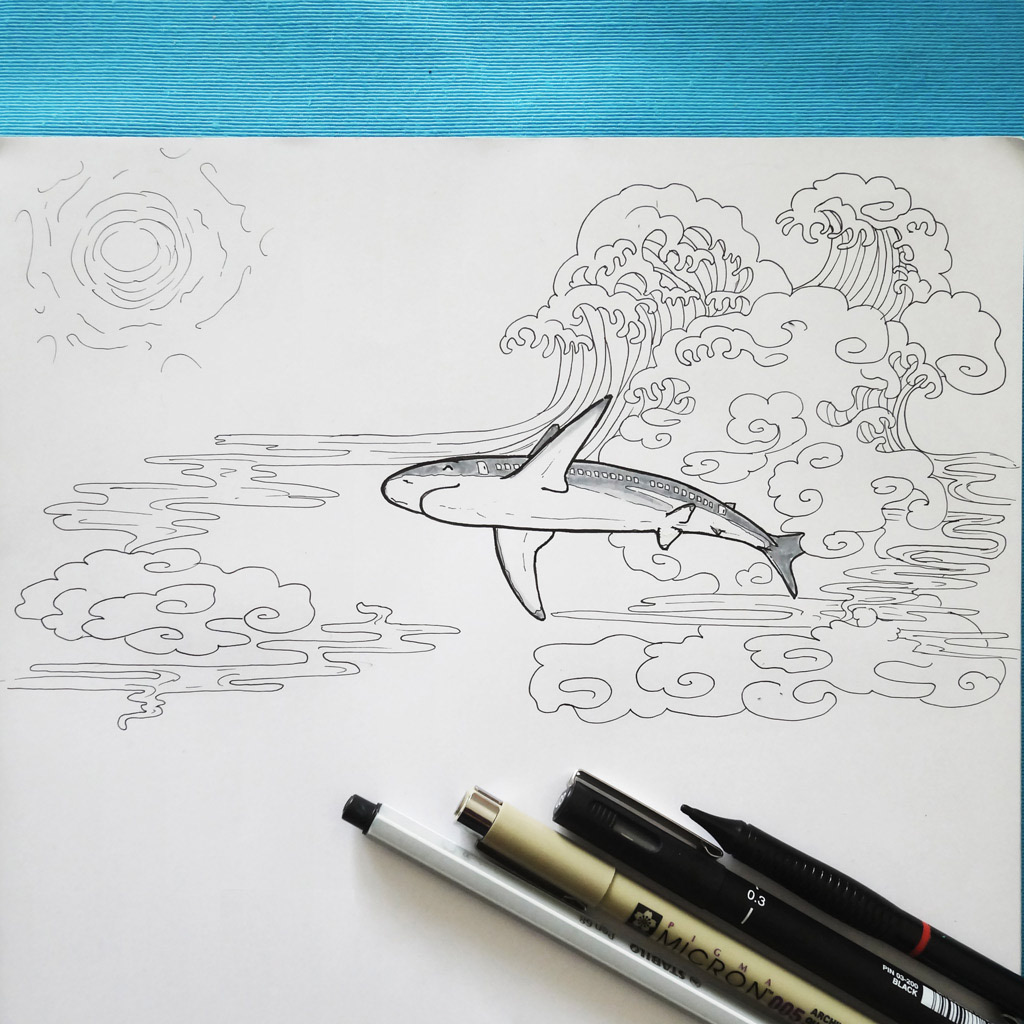

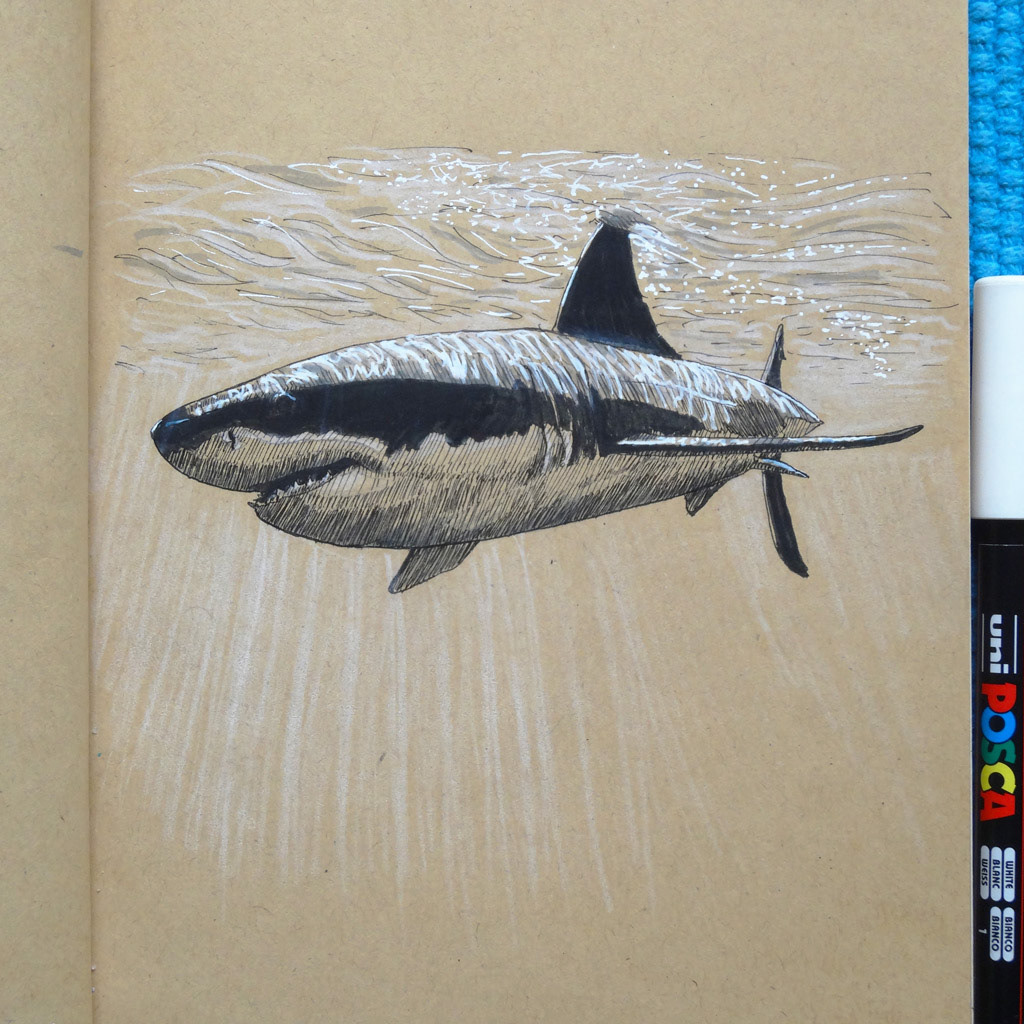

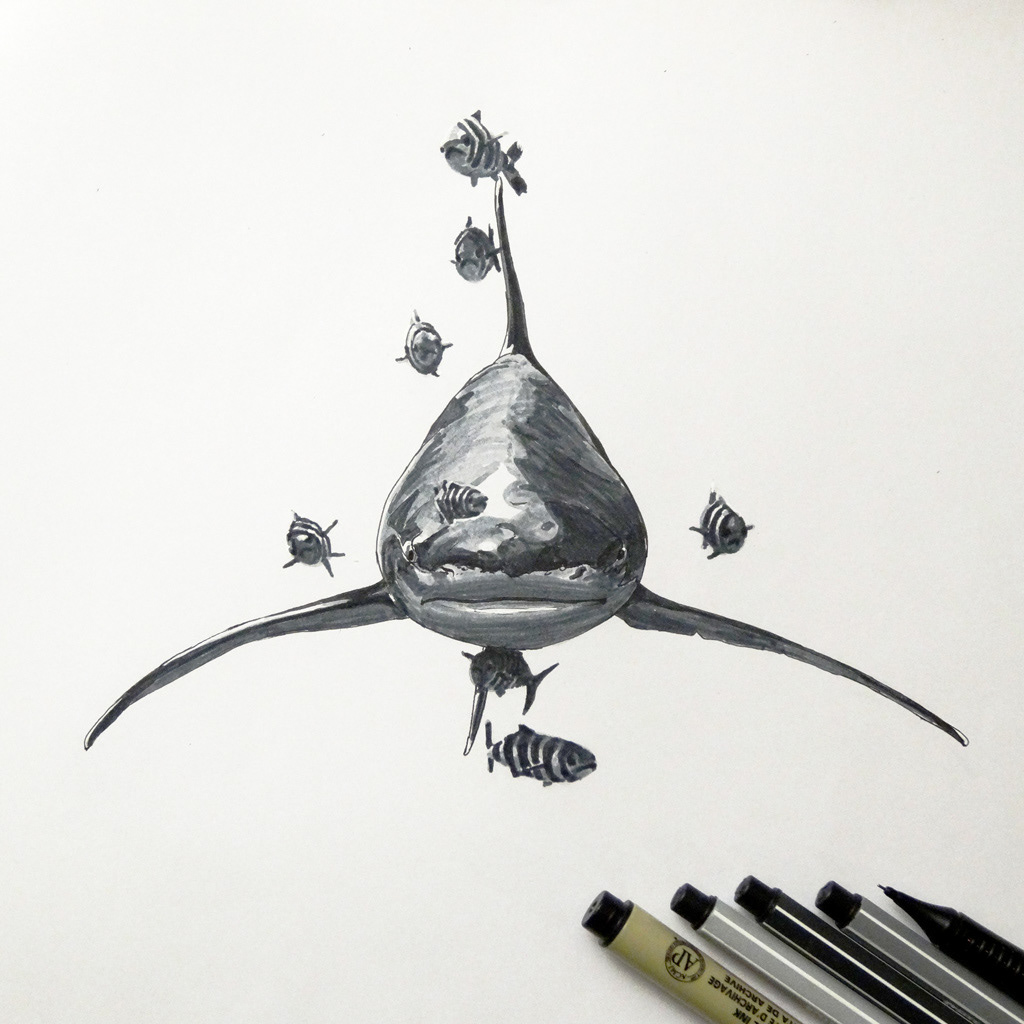
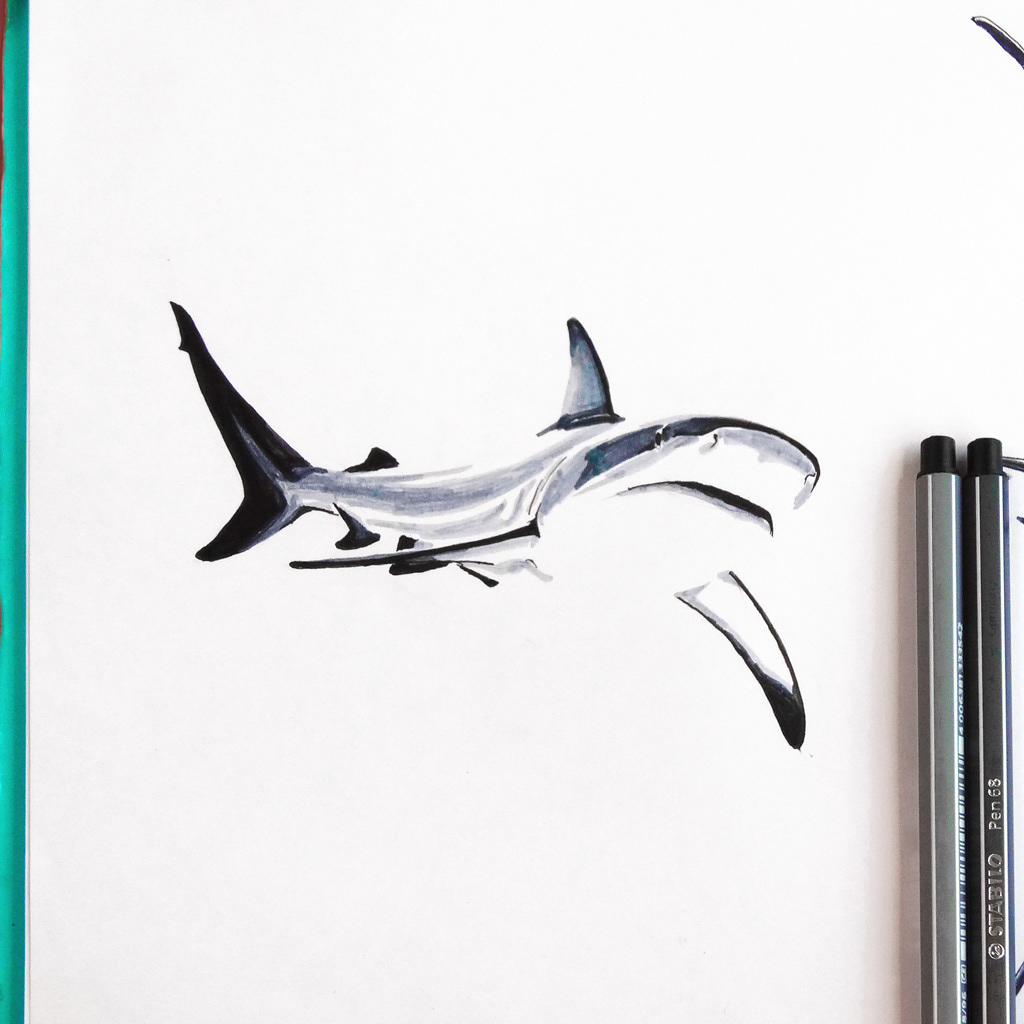
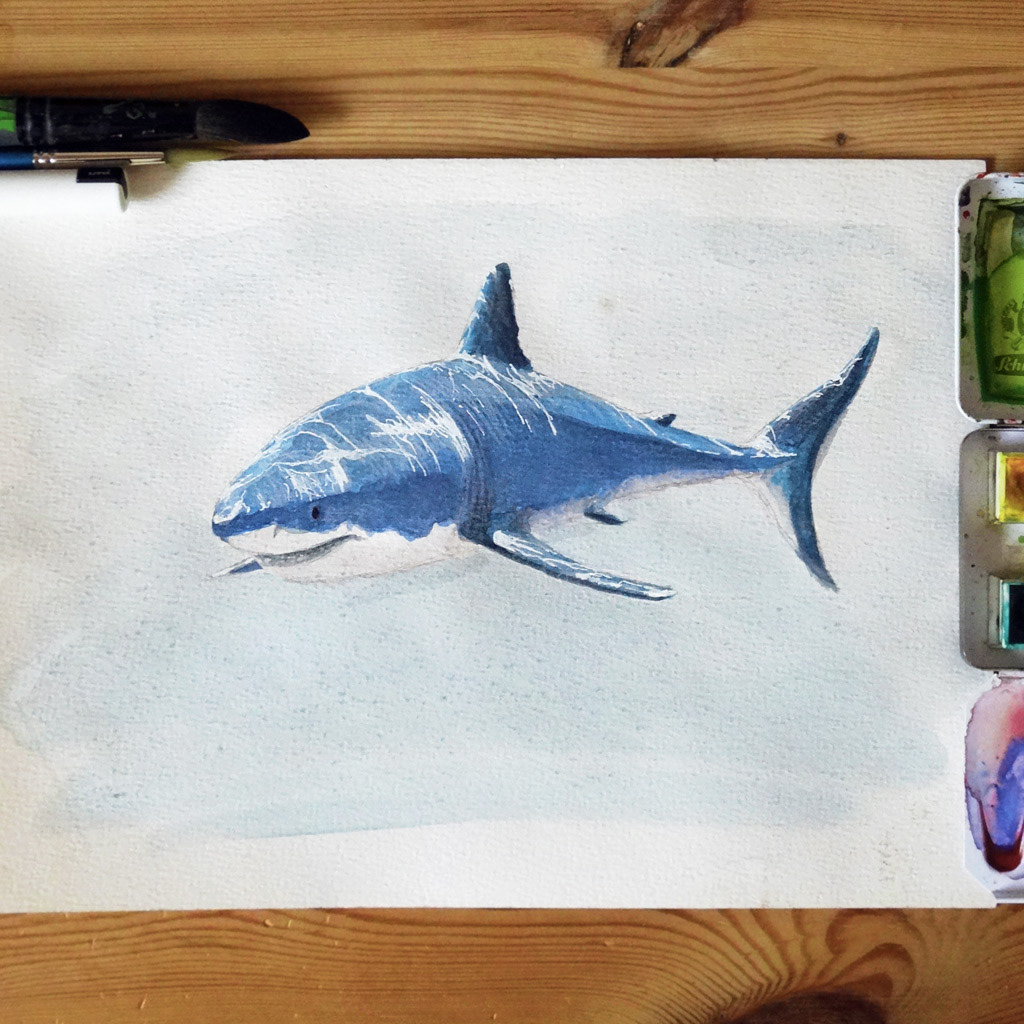
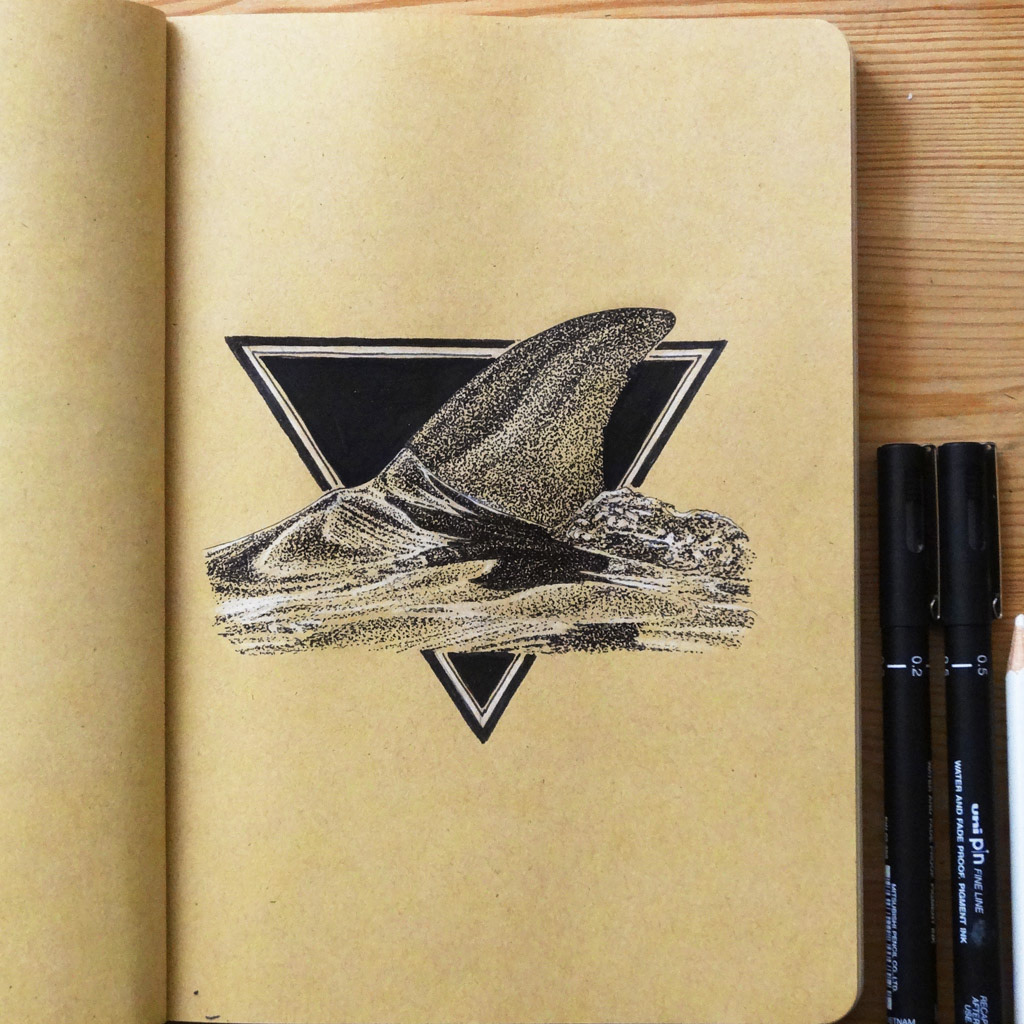
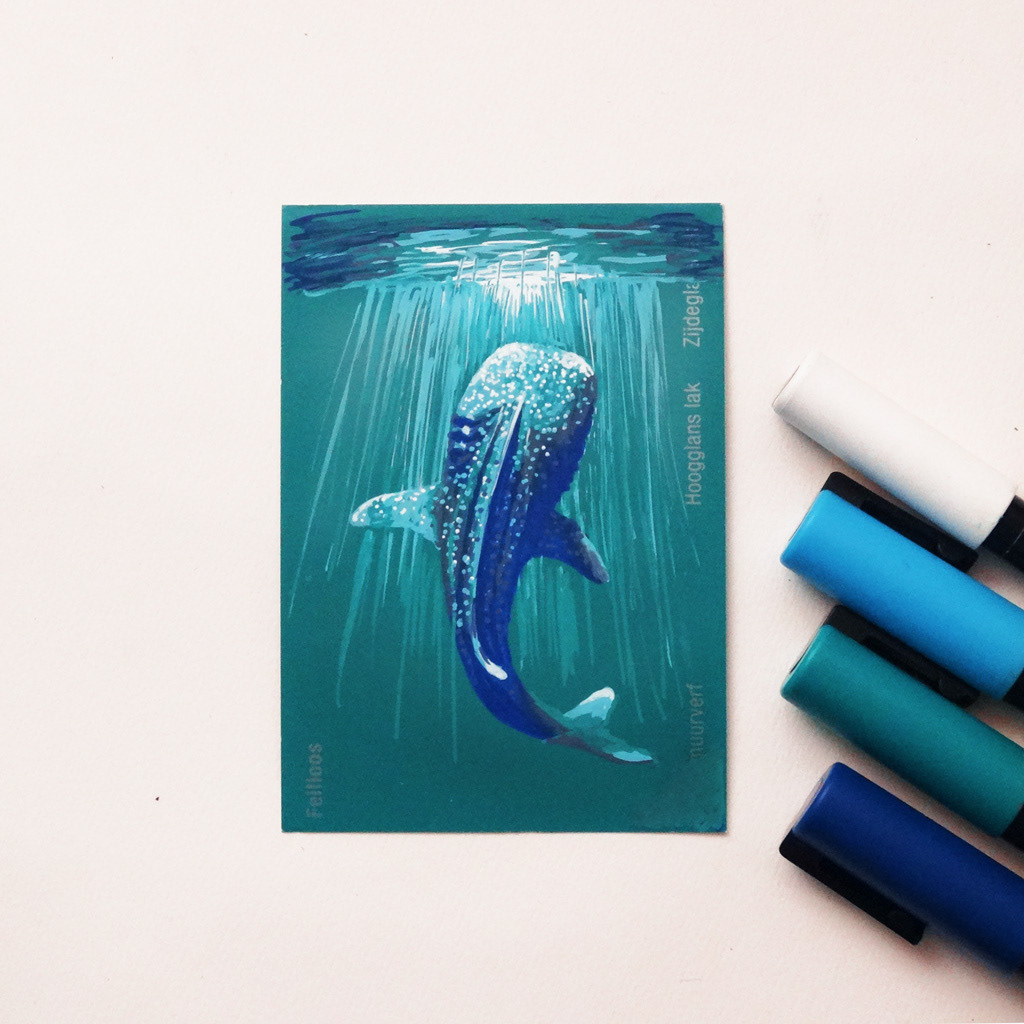
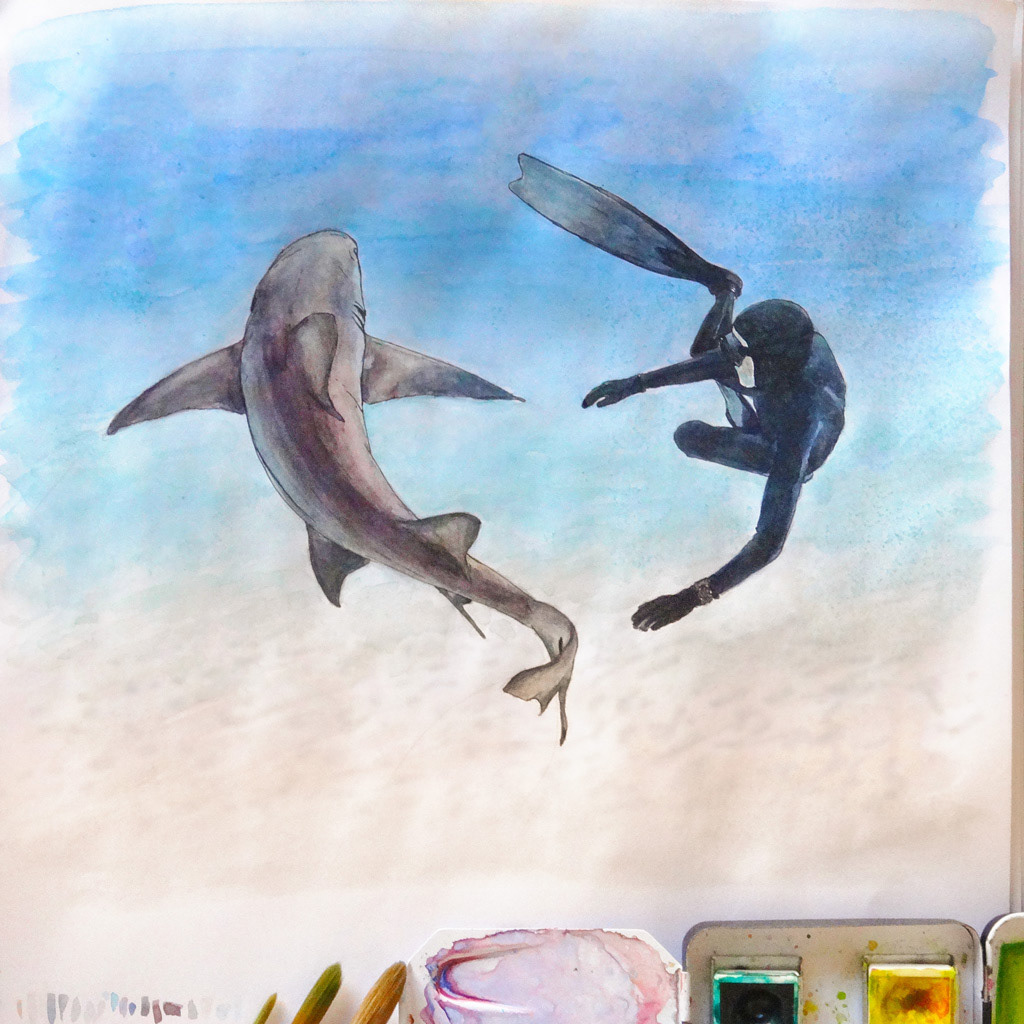
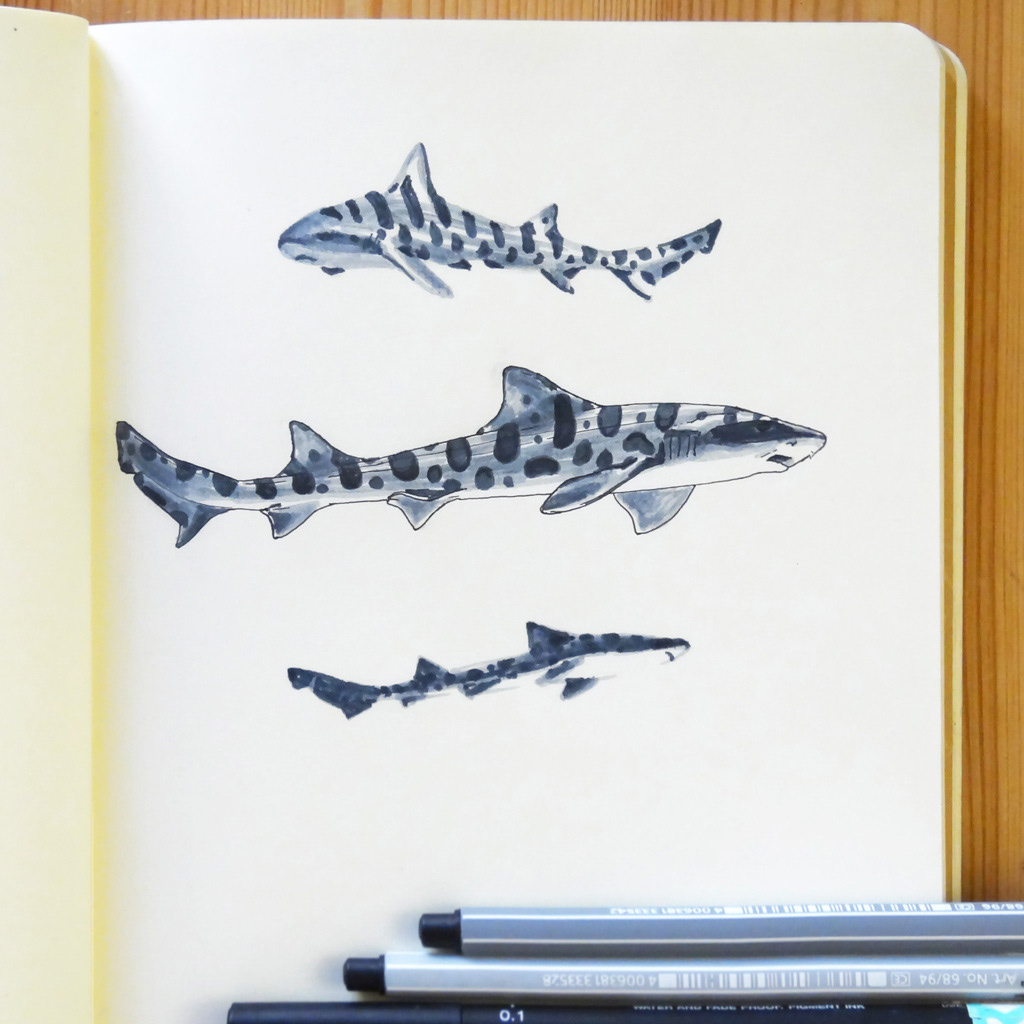
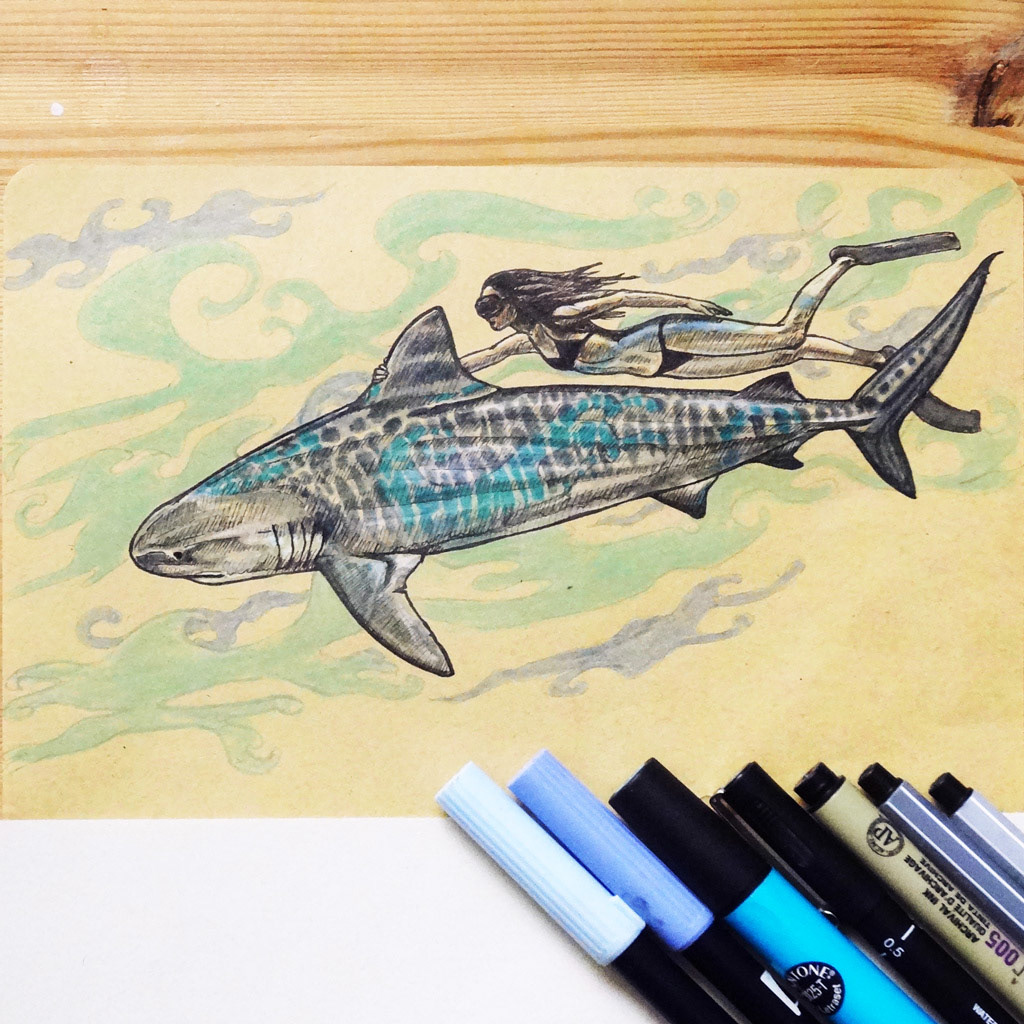
Thanks for viewing!!!
